Baseball in Early Los Angeles
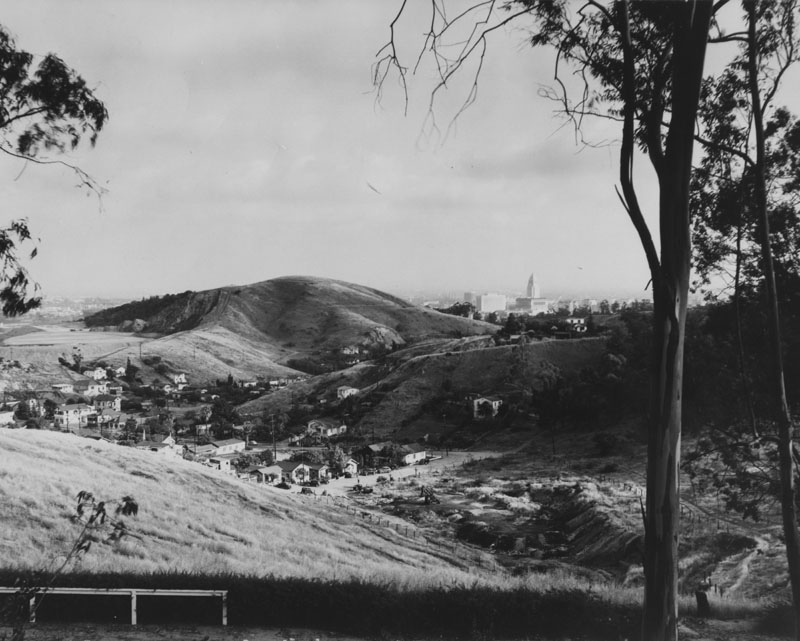 |
|
| (ca. 1952)* - A panoramic view of Chavez Ravine, showing the residential community. The Los Angeles Civic Center is visible in the background. |
Historical Notes The land for Dodger Stadium was purchased from local owners and inhabitants in the early 1950s by the city of Los Angeles using eminent domain with funds from the Federal Housing Act of 1949. The city had planned to develop the Elysian Park Heights public housing project, which included two dozen 13-story buildings and more than 160 two-story townhouses, in addition to newly rebuilt playgrounds and schools. |
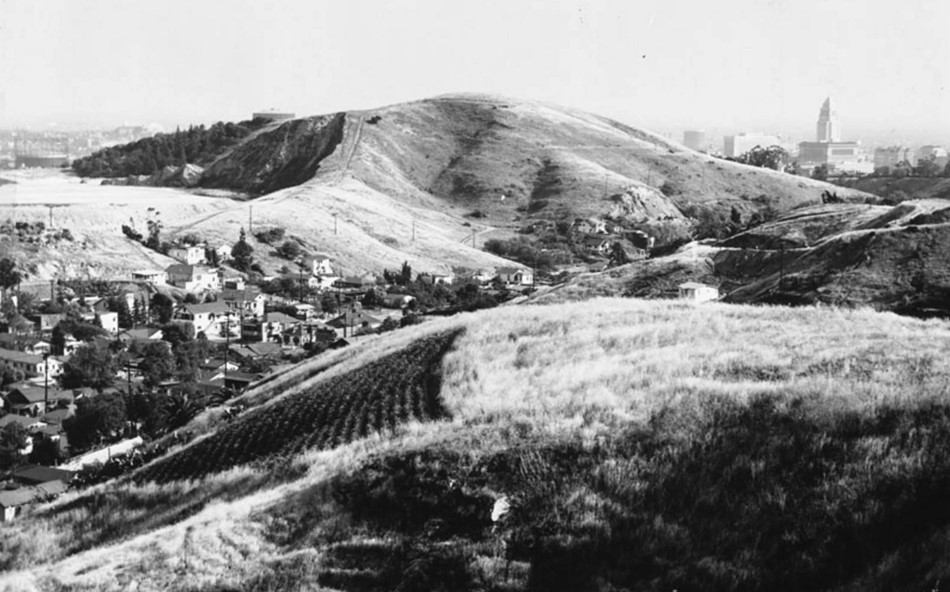 |
|
| (ca. 1952)* - A panoramic view of Chavez Ravine, future site of Dodger Stadium. |
Historical Notes Before construction could begin on the housing project, the local political climate changed greatly when Norris Poulson was elected mayor of Los Angeles in 1953. By then, the proposed public housing projects like Elysian Park Heights lost most of their support. Following protracted negotiations, the city purchased the Chavez Ravine property back from the Federal Housing Authority at a drastically reduced price, with the stipulation that the land be used for a public purpose. It was not until June 3, 1958, when Los Angeles voters approved a "Taxpayers Committee for Yes on Baseball" referendum, that the Dodgers were able to acquire 352 acres of Chavez Ravine from the city. The Chavez Ravine controversy was a significant event in the history of Los Angeles. It was a complex situation that involved urban redevelopment, political maneuvering, and the displacement of an entire community. |
 |
|
| (1957)* - On October 7, 1957, Walter O'Malley announced that he was moving the Dodgers west and that he would build a new stadium on land in Chavez Ravine. Here, a man points out the future location of home plate. The police academy can be seen in the far background. |
Historical Notes In the mid-1950s, Brooklyn Dodger team president Walter O'Malley had tried to build a domed stadium in the New York City borough of Brooklyn, but was unable to reach an agreement with city officials on land acquisition, and eventually reached a deal with the city of Los Angeles. The rest is history. |
Dodgers Move to Los Angeles
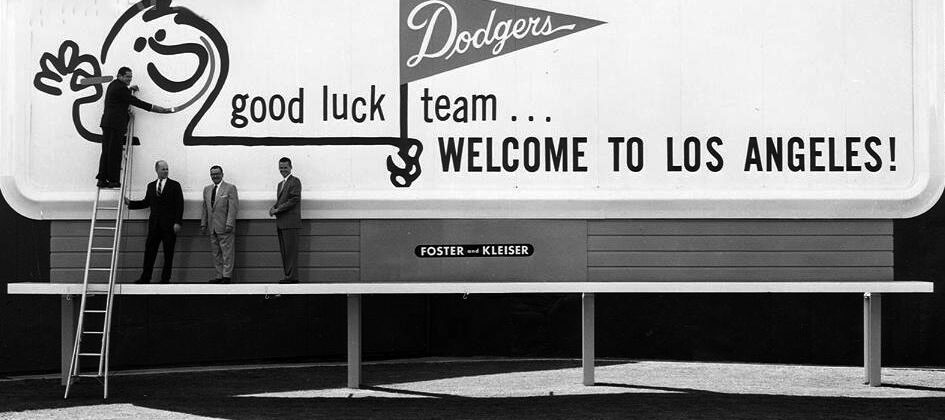 |
|
| (1958)* - A new signboard welcomes the Dodgers to Los Angeles. |
Historical Notes The Brooklyn Dodgers' move to Los Angeles for the 1958 season was a major turning point in Major League Baseball history and part of a wave of team relocations during the 1950s and 1960s. The decision to leave Brooklyn came after years of challenges, including an outdated stadium, Ebbets Field, which lacked parking for the growing number of car-owning fans. Despite being financially successful, Dodgers' owner Walter O'Malley wanted a new stadium but couldn't reach an agreement with New York officials. Instead, he began exploring opportunities in Los Angeles, a city with no MLB team and a booming population. On May 28, 1957, the National League approved the move, along with the New York Giants’ relocation to San Francisco, ensuring both teams would move to California together. The Dodgers officially announced the move on October 8, 1957, and played their first game in Los Angeles on April 18, 1958, drawing a crowd of 78,672 at the Los Angeles Memorial Coliseum. The move was celebrated in Los Angeles as a boost to the local economy, but it left New York fans heartbroken. It also marked the first time Major League Baseball expanded to the West Coast, increasing the league's national presence. |
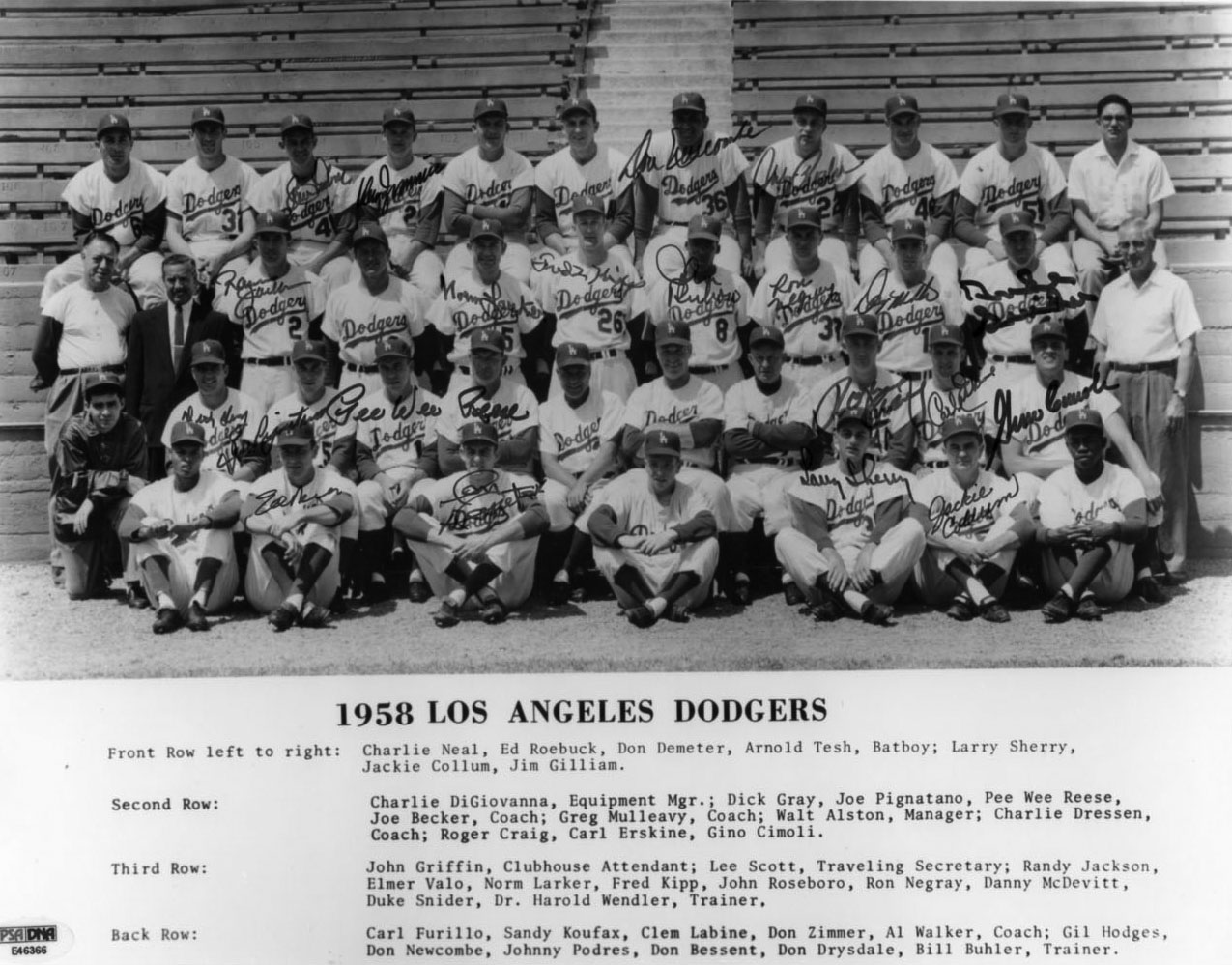 |
|
| (1958)* - Team photo of the new Los Angeles Dodgers, transplanted from Brooklyn. |
Historical Notes While Dodger Stadium was under construction, the Dodgers played in the league's largest capacity venue from 1958 through 1961 at their temporary home, the Los Angeles Memorial Coliseum. Click HERE to see the Dodgers at the Los Angeles Memorial Coliseum. |
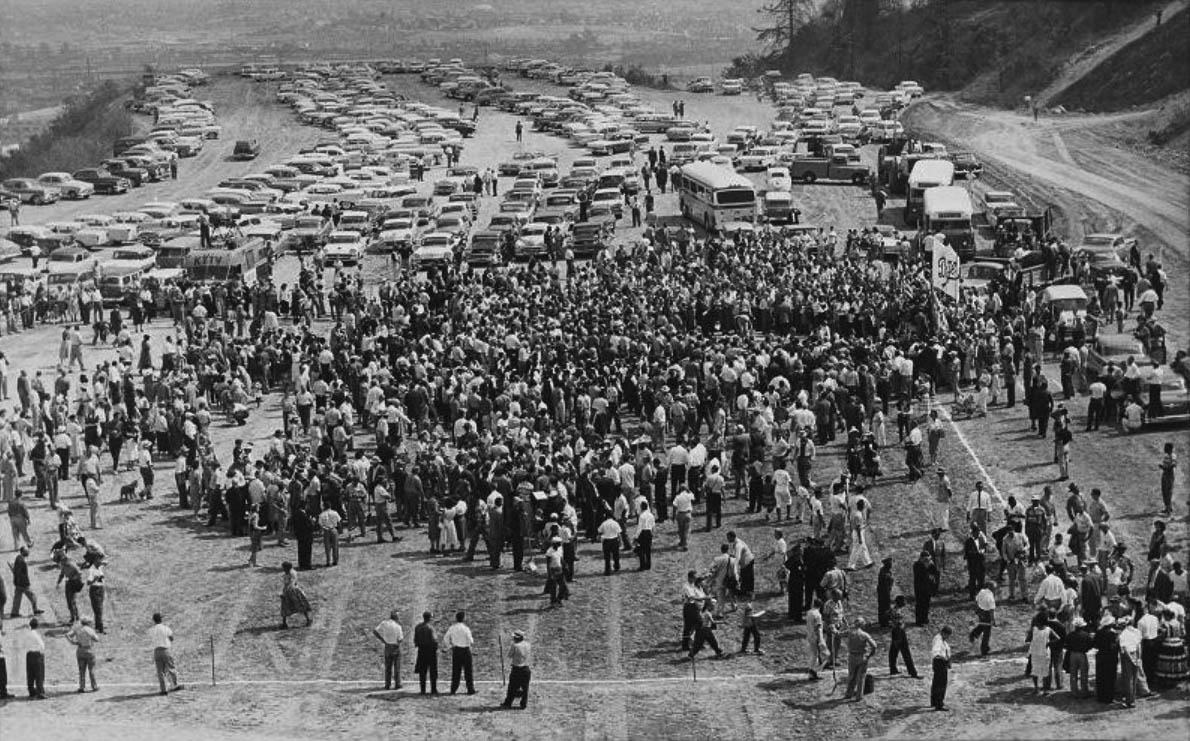 |
|
| (1959)* – View showing a crowd gathered for the new Dodgers Stadium ground-breaking ceremony in Chavez Ravine, Los Angeles. |
Historical Notes A crowd estimated at more than 5,000 was on hand in the Chavez Ravine section of Los Angeles Sept. 17 as ground was broken for the Los Angeles Dodgers' new $12,000,000 baseball plant. White lines represent the approximate location of the diamond, with the plate at lower right. Dodger players took positions on the diamond, but were quickly swarmed over by autograph seekers. |
 |
|
| (1959)* - Hundreds of onlookers watch bulldozers charging down the hills to begin the massive leveling and grading process for Dodger Stadium. In all, eight million cubic yards of earth were moved to prepare the rugged land for the building of Dodger Stadium. Photo dated: September 17, 1959. |
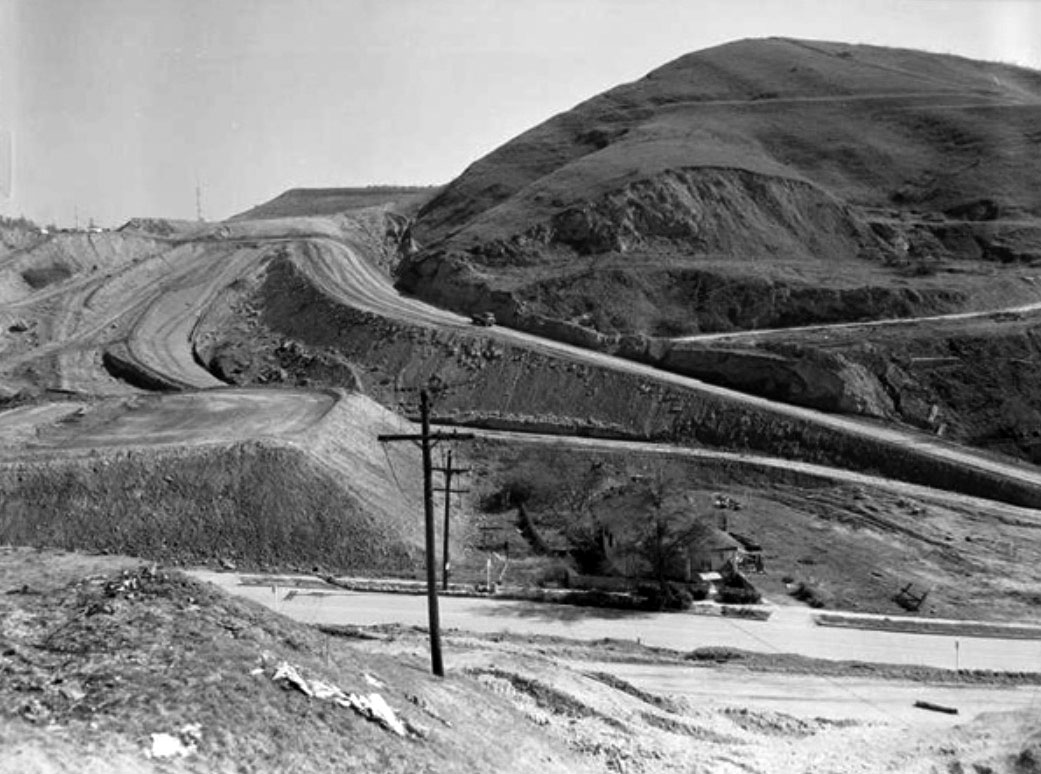 |
|
| (1960 )*^* - Los Angeles Times photo showing a lone house amid construction for Dodger Stadium. |
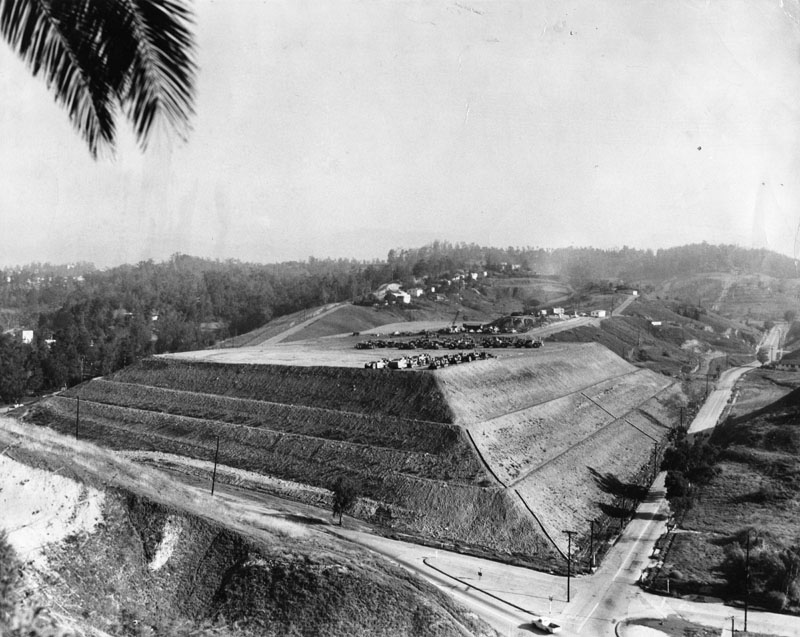 |
|
| (1960)* - Construction of Dodger Stadium, built for $23 million, the first privately financed Major League Baseball stadium since Yankee Stadium was built in the 1920s. According to the Herald-Examiner's Morton Moss, Chavez Ravine had turned into a "vast monument of multi-colored steel concrete and terraced asphalt surrounding a barbered acreage of scalloped greenery." |
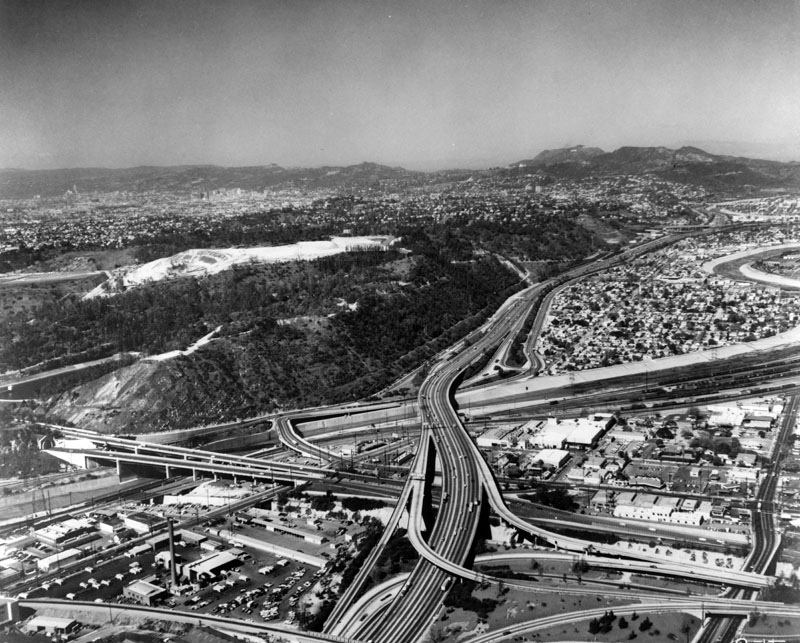 |
|
| (ca. 1960)* - Aerial view of Chávez Ravine (hill on the left) and Dodger Stadium under construction, as well as the numerous freeway "veins" that run through the city of Los Angeles. Hundreds of homes are also visible in the surrounding areas as far as the eye can see. |
 |
|
| (1960)^#^ - Primary grading of Chavez Ravine. LA Times caption reads: “With preliminary grading finished, Dodgers hope to get going on new park sometime in June.” Photo Date: April 12, 1960 |
 |
|
| (1960)^ - Photograph of Chavez Ravine Dodger Stadium excavation. "No action -- legal snarls again stalled construction of Dodger's new baseball park in Chavez Ravine, where idle trucks, bulldozers and earth-movers are pictured late Tuesday" -- Examiner clipping attached to verso, dated, "May 25, 1960". |
Historical Notes In a little less than 31 months, nineteen giant earthmovers relocated eight million cubic yards of earth, flattening hills and filling in gullies across the 300-acre site. At the highest point, a 726-foot promontory variously called Mount Lookout, Silverwood Hill, and O'Malley Hill, they amputated the peak and carved an amphitheater into the mountainside that would serve as the stadium's foundation. |
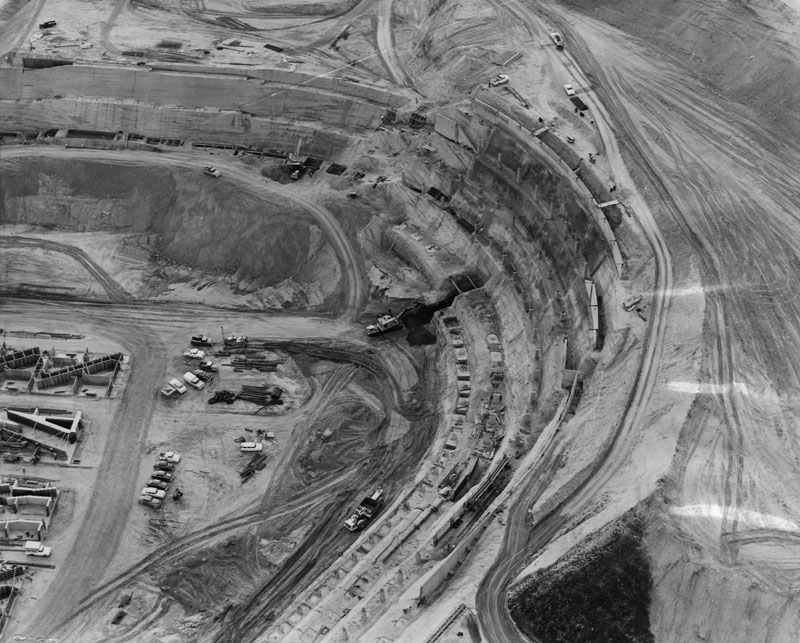 |
|
| (1961)* - Photograph caption dated February 16, 1961 reads, "Dirt tiers will soon support stands for 56,200-seat Dodger Bowl for 1962." |
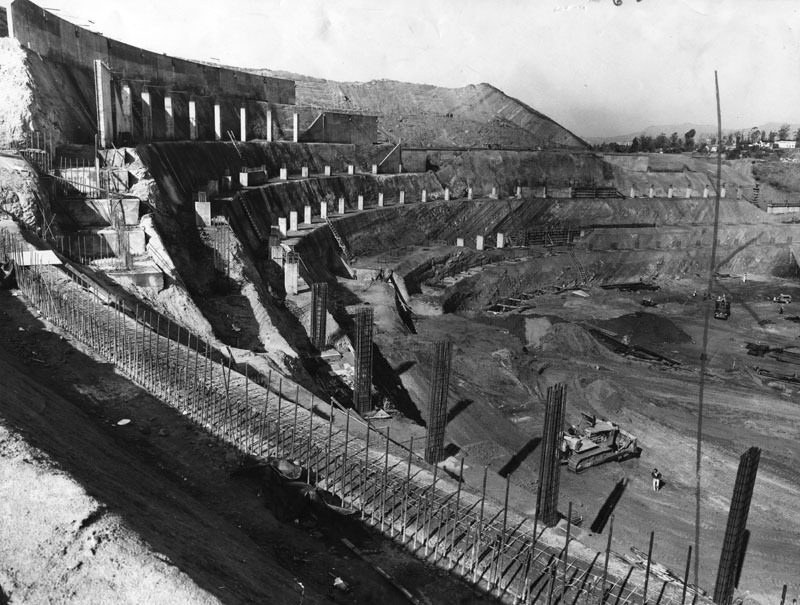 |
|
| (1961)* - Photograph caption reads, "Work ahead of schedule in Chavez Ravine." |
Historical Notes Some 40,000 cubic yards of concrete, including 78 precast frames, and 13 million pounds of reinforcing steel went into building the 124-foot grandstand. |
 |
|
| (1961)* - Dodger Stadium under construction. |
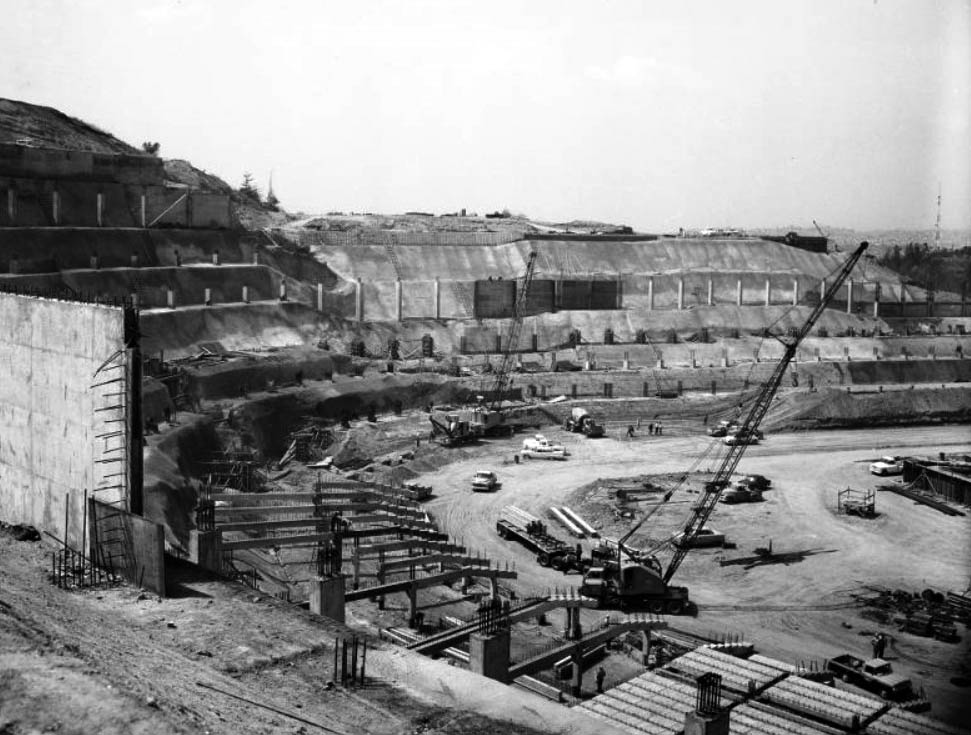 |
|
| (1961)^ – View showing Dodger Stadium under construction. Photo Date: April 7, 1961 |
Historical Notes Because the largest precast pieces were too big to move by truck, a six-acre casting yard was built on the site. To assemble the pieces, the contractor imported a $150,000 crane from Germany that was then was the largest in North America. |
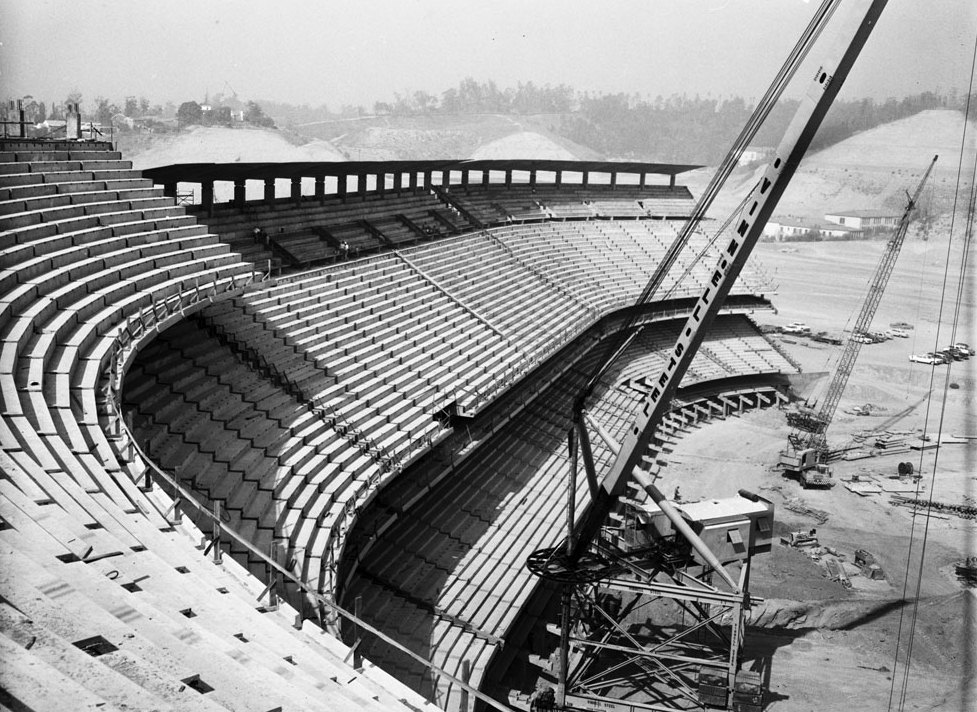 |
|
| (1961)^ - Pan shot of ball park starting to take shape. Note the extra-large crane in the foreground. |
Historical Notes The grandstand's cantilevered design meant that each spectator enjoyed an unobstructed view of the action—a departure from older stadium designs that placed support structures between fans and the field. |
 |
|
| (ca. 1961)* - Aerial view of downtown Los Angeles, showing Dodger Stadium during the final stages of its construction in the foreground. |
Historical Notes At the project's peak, there were 342 construction workers on the site. Total costs ran close to $23 million, including $4.47 million in city and county subsidies. |
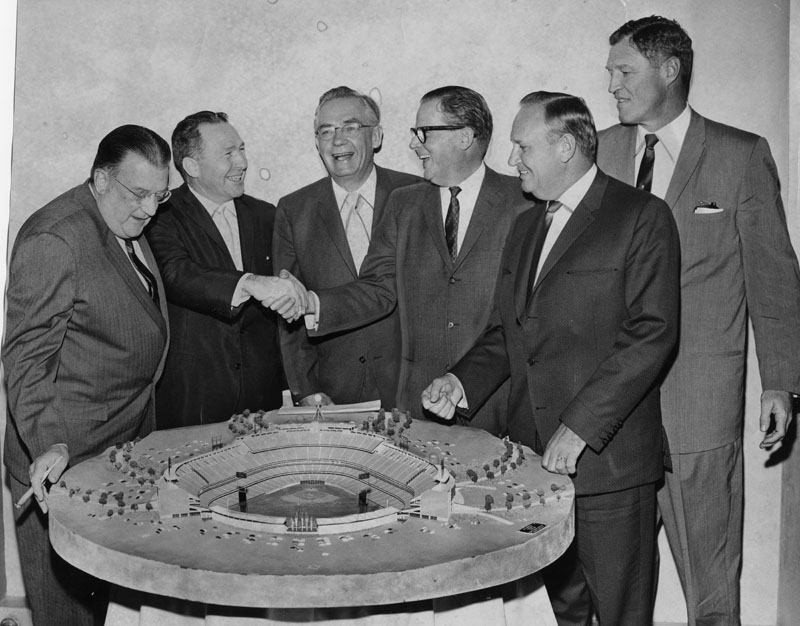 |
|
| (1961)* - Photograph caption dated December 12, 1961 reads, "Plans were revealed yesterday for a gigantic civic celebration in conjunction with the opening of the new Dodger Stadium next April. Shown admiring the model of the baseball showplace are: Walter O'Malley, Dodger president; Mayor Sam Yorty; H.C. McClellan, chairman of the dedication committee; ex-mayor Norris Poulson; Gene Autry, Angel owner; and Bob Reynolds, Angel president." |
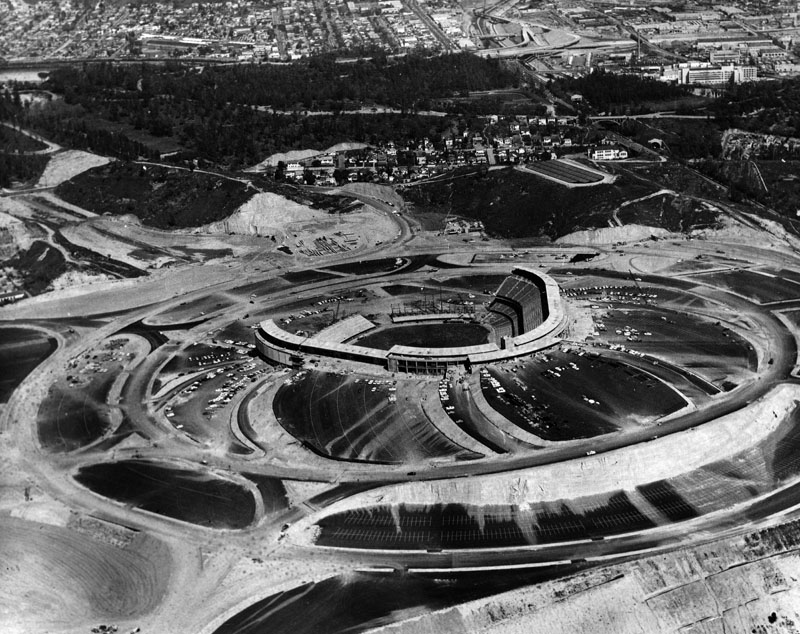 |
|
| (1962)* - Dodger Stadium nearing completion. Work is being finished on the tiered parking lot that surrounds the stadium. |
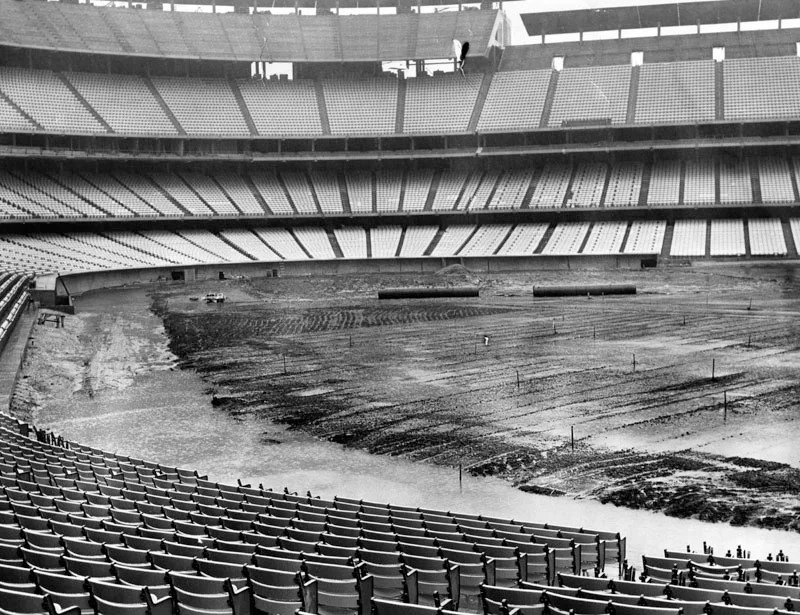 |
|
| (1962)* - Spring storms delayed the completion of work on Dodger Stadium's field, seen here on February 23, 1962. |
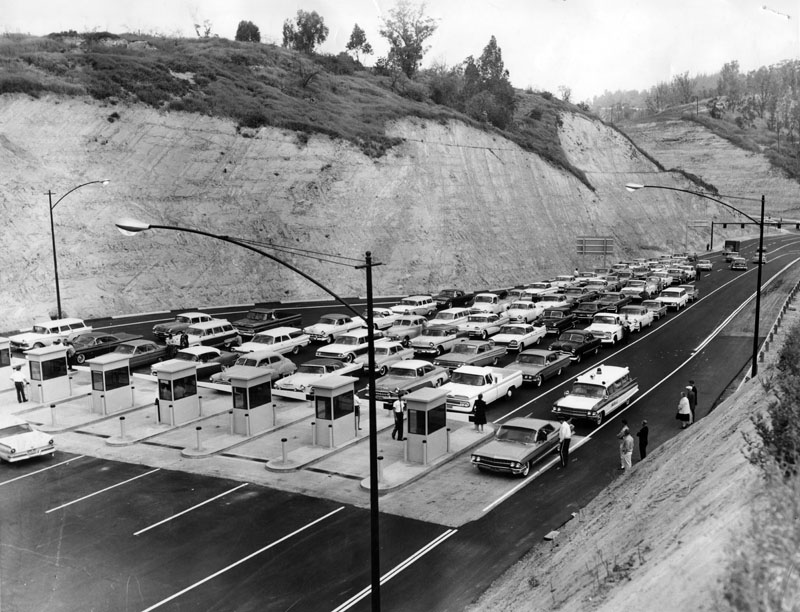 |
|
| (1962)* - Photograph caption dated April 10, 1962 reads, "No, this isn't an on-ramp to a toll road. Nor is it a traffic jam. It's an auto lineup of anxious baseball fans waiting at Solano Street entrance to new Dodger Stadium today. Note ambulance waiting in extreme right lane of photo. Solano entrance is one of five access roads busy early today routing 56,000 fans making beeline to Dodger opener in $18 million stadium." |
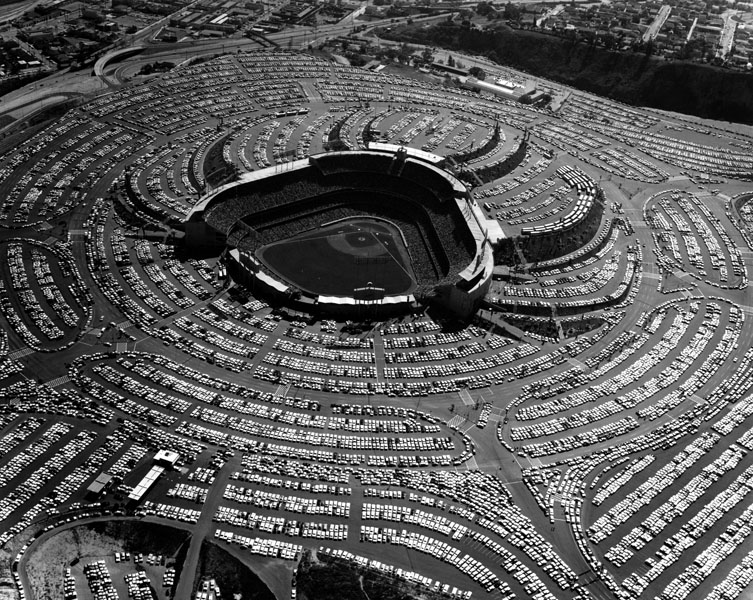 |
|
| (1960s)* - Aerial view of Dodger Stadium and parking lot filled to capacity. |
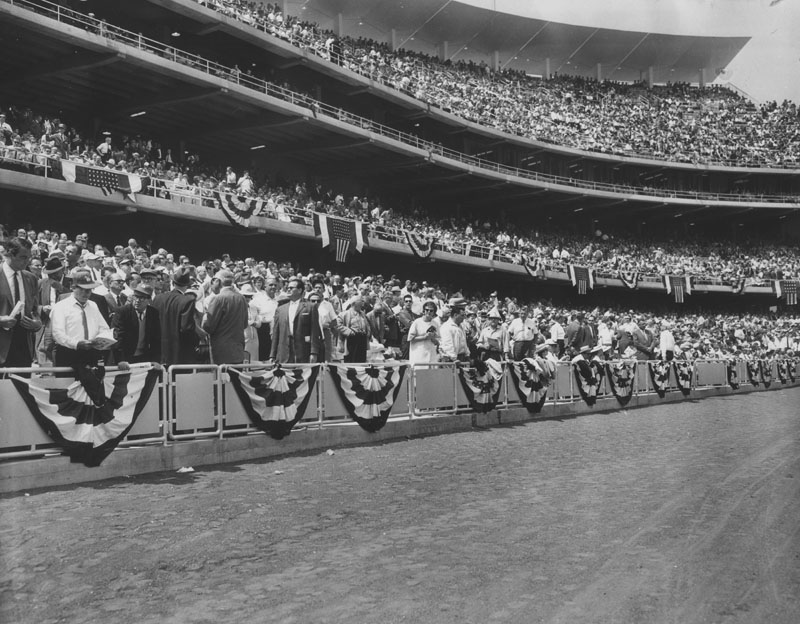 |
|
| (1962)* - Opening Day: April 10, 1962. Fans lined up to see the new ballpark, then awaited the first pitch. The Dodgers lost, 6-3, to the Cincinnati Reds, the defending National League champs, before 52,564 fans. That year, the Dodgers drew 2.7 million fans, the most in baseball history to that point. |
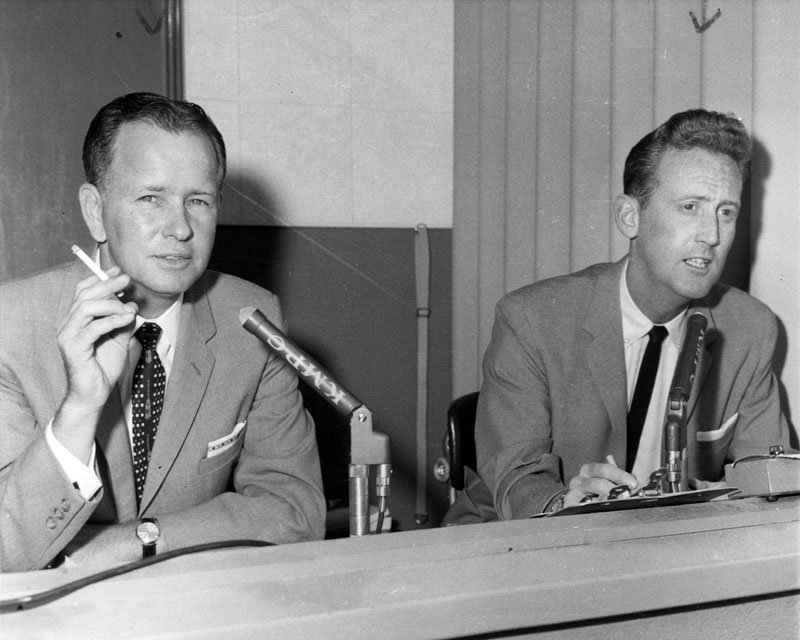 |
|
| (ca. 1959)* - Sportscasters Jerry Doggett (left) and Vin Scully doing their thing. |
Historical Notes Jerry Doggett broadcast Dodgers games from 1956-1987; Vin Scully has been broadcasting the games since 1950. |
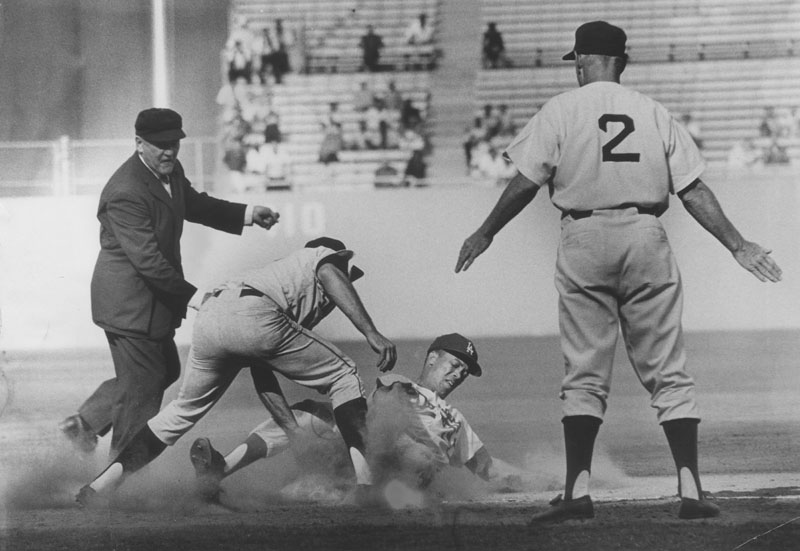 |
|
| (1962)* - During the Dodgers' first years in L.A., shortstop Maury Wills sparked the team's meager offense. Wills led the National League in stolen bases from 1960-1966, and shattered Ty Cobb's 47-year-old record of 97 stolen bases by swiping 104 in 1962. Despite the fact that L.A. lost its lead over the rival Giants in the 1962 pennant race, Wills won MVP. |
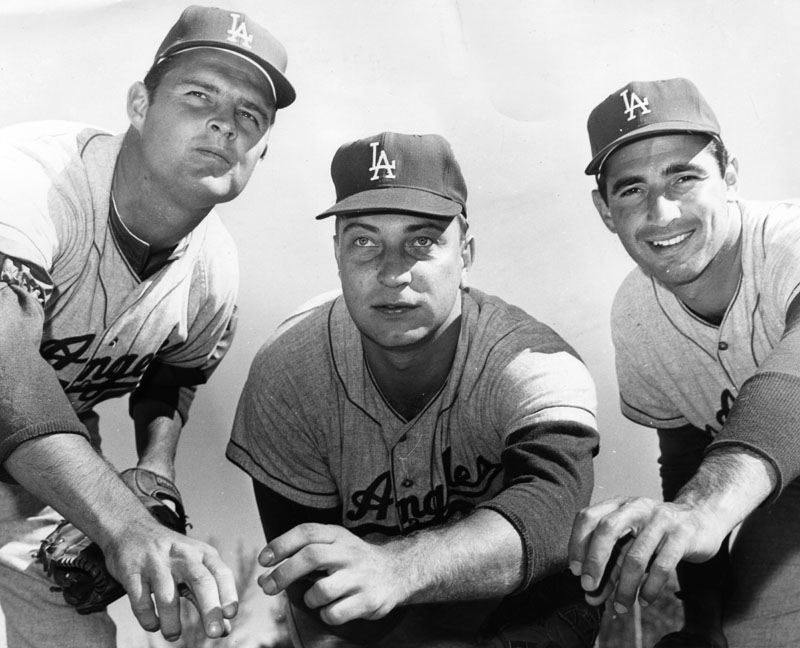 |
|
| (1963)* - Dodger pitchers, from left: right-hander, Don Drysdale; and left-handers, Johnny Podres and Sandy Koufax. Photo dated: March 13, 1963. |
Historical Notes They were the most dominating 1-2 pitching punch in Los Angeles history, combining during a five-year period from 1962-66 for 209 regular-season victories, 53 shutouts and four Cy Young Awards. And they only pitched for the Dodgers and manager Walter Alston, two of many parallels to the respective careers of Hall of Famers Sandy Koufax and Don Drysdale. Johnny Podres spent most of his career with the Brooklyn and Los Angeles Dodgers. He is perhaps best remembered for being named the Most Valuable Player of the 1955 World Series, pitching a shutout in Game 7 against the New York Yankees to help bring the Dodgers their only World Series title in Brooklyn before their move to Los Angeles after the 1957 season. |
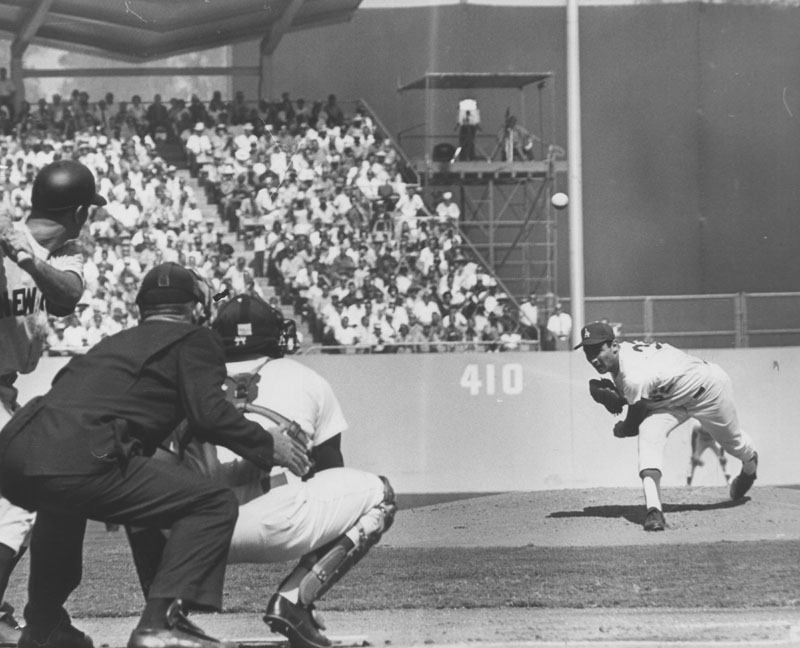 |
|
| (1963)* - Sandy Koufax pitching in Game 4 of the 1963 World Series against the Yankees. The date of that game was Oct. 6, 1963. Photo: Los Angeles Dodgers |
Historical Notes Like Drysdale, Sandy Koufax began his career in Brooklyn. Like Drysdale, he came into his own in L.A. And, like Drysdale, he retired because of an arm injury. Beginning in 1961, Koufax won 25 or more games three times and led L.A. to three World Series titles. One of the few elite Jewish athletes, he refused to pitch the opening game of the 1965 World Series because it fell on Yom Kippur. With the Series tied at 3-3, Koufax pitched the seventh and deciding game on two days rest--and beat the Minnesota Twins, 2-0. The "Left Hand of God," indeed. Koufax's career peaked with a run of six outstanding seasons from 1961 to 1966, before arthritis in his left elbow ended his career prematurely at age 30. He was named the National League's Most Valuable Player in 1963. He also won the 1963, 1965, and 1966 Cy Young Awards by unanimous votes, making him the first 3-time Cy Young winner in baseball history and the only one to win 3 times when the award was for all of baseball, not just one league. In each of his Cy Young seasons, Koufax won the pitcher's triple crown by leading the NL in wins, strikeouts, and earned run average. Koufax's totals would also have led the American League in those seasons. Koufax was the first major leaguer to pitch four no-hitters (including the eighth perfect game in baseball history). Despite his comparatively short career, Koufax's 2,396 career strikeouts ranked 7th in history as of his retirement, trailing only Warren Spahn (2,583) among left-handers. Koufax and Nolan Ryan are the only two pitchers inducted into the Hall of Fame who had more strikeouts than innings pitched. |
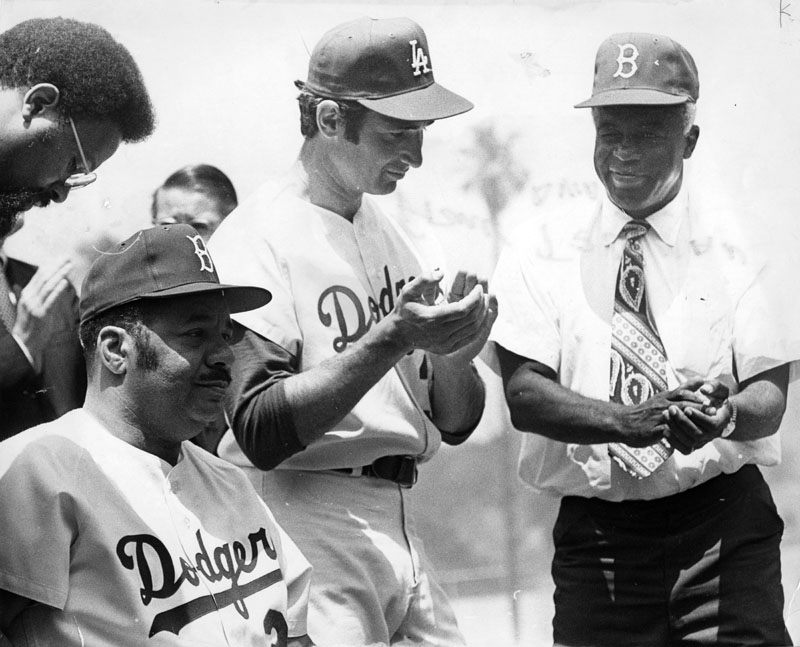 |
|
| (1972)* - Photograph caption reads: "Two stars from Brooklyn flank great one from Los Angeles, as Roy Campanella (left), Sandy Koufax (center) and Jackie Robinson get together." Photograph dated June 5, 1972. |
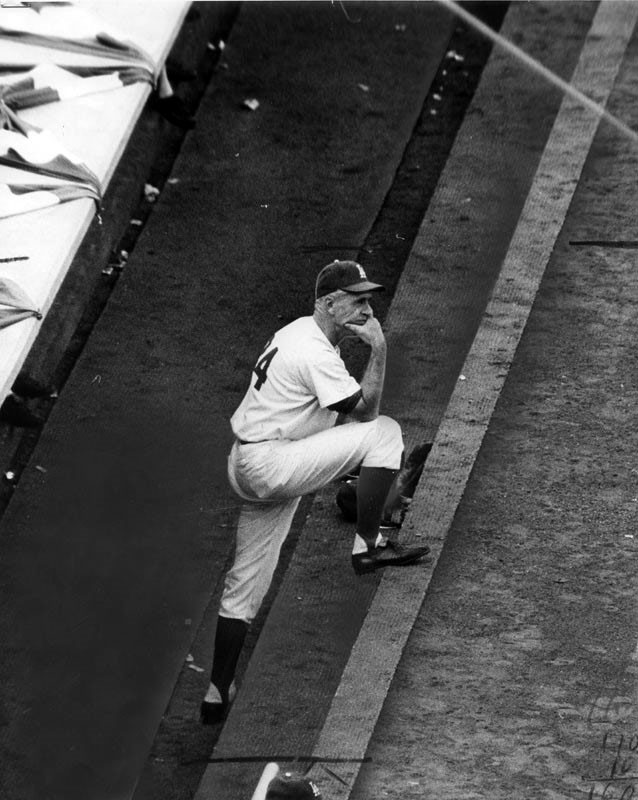 |
|
| (1966)* – View showing Walter Alston looking on from the dugout. |
Historical Notes When the Dodgers hired manager Walter Alston before the 1954 season, he signed a one-year contract. Some 23 year later, he continued to labor under those terms. Alston won four World Series and over 2,000 games before being replaced by Tommy Lasorda before the 1977 season. He died in 1984. |
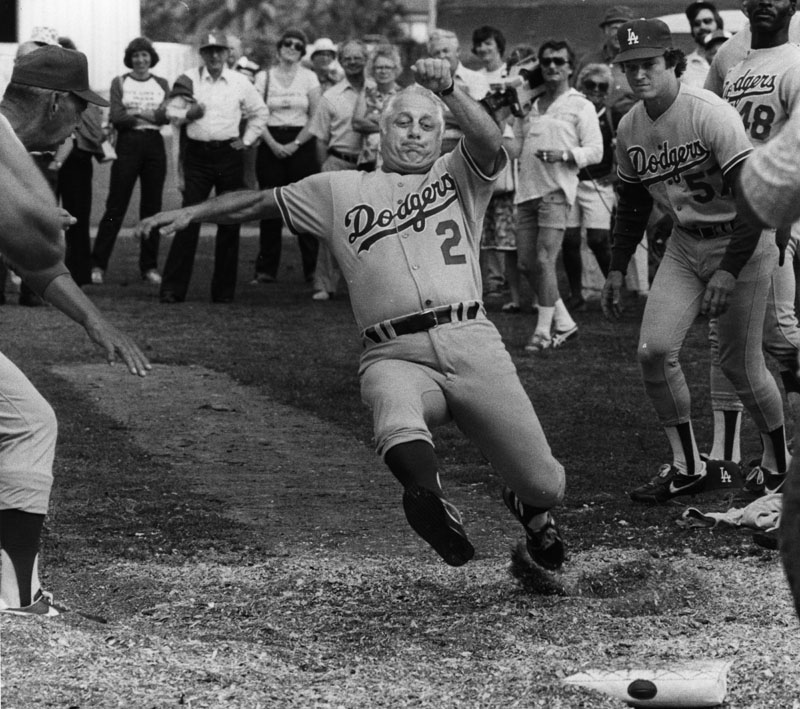 |
|
| (n.d.)* - Dodger players and onlookers in background, watch as Tommy Lasorda slides into base bag. |
Historical Notes Tommy Lasorda's first off-field assignment with the Dodgers was as a scout from 1961 to 1965. In 1966, he became the manager for the Pocatello Chiefs in the rookie leagues, then managed the Ogden Dodgers to three Pioneer League championships from 1966–68. He became the Dodgers AAA Pacific Coast League manager in 1969 with the Spokane Indians (1969–71) and remained in the position when the Dodgers switched their AAA farm club to the Albuquerque Dukes (1972). His 1972 Dukes team won the PCL Championship. Lasorda was also a manager for the Dominican Winter Baseball League team Tigres del Licey (Licey Tigers). He led the team to the 1973 Caribbean World Series Title in Venezuela with a series record of 5 wins and 1 loss. In 1973, Lasorda became the third-base coach on the staff of Hall of Fame manager Walter Alston, serving for almost four seasons. He was widely regarded as Alston's heir apparent, and turned down several major league managing jobs elsewhere to remain in the Dodger fold. |
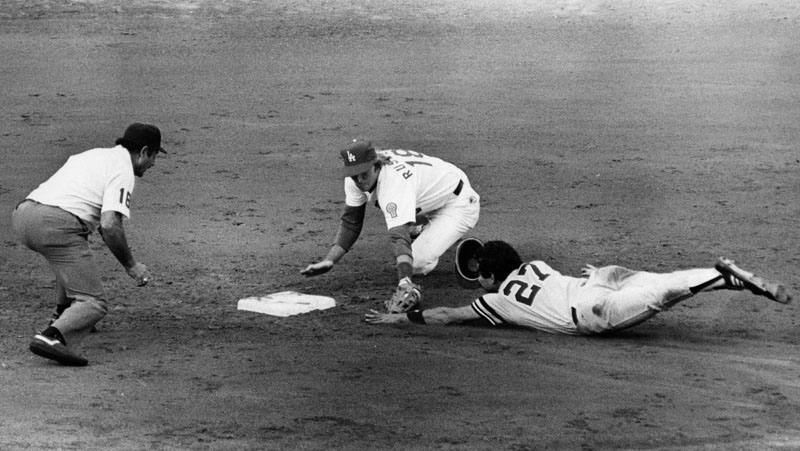 |
|
| (n.d.)* - Runner tries to stretch his hand towards base as Dodger Bill Russell makes the tag on his left hand. Umpire standing on left calls "out". |
Historical Notes Bill Russell played his entire 18-year, 2,181-game career with the Los Angeles Dodgers as the starting shortstop for four National League pennant winners and one World Series champion. He also served as the team's manager from 1996 to 1998. |
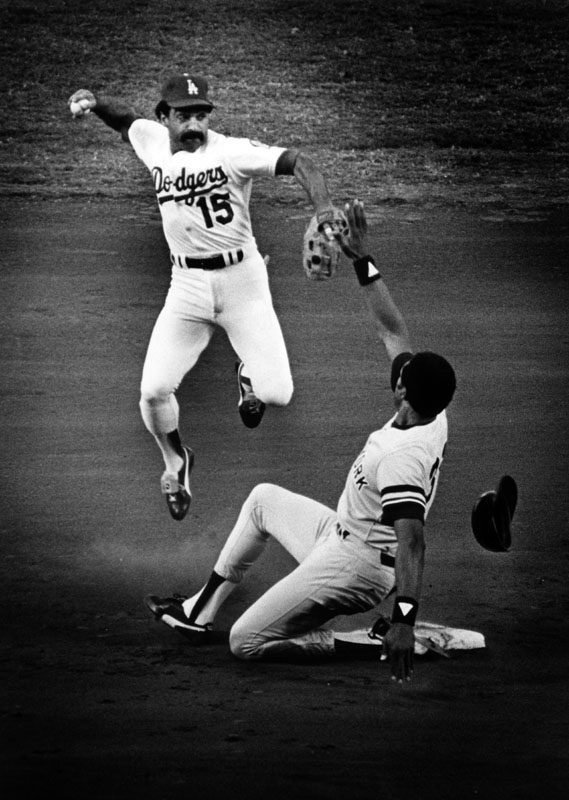 |
|
| (n.d.)* - Davey Lopes turns a double play in the first inning of the Dogers vs Yankees game. |
Historical Notes Lopes spent nine seasons with the Los Angeles Dodgers as their regular second baseman. Along with Steve Garvey (1B), Bill Russell (SS) and Ron Cey (3B), they formed the longest running infield in baseball history, which stayed together for eight and a half seasons. |
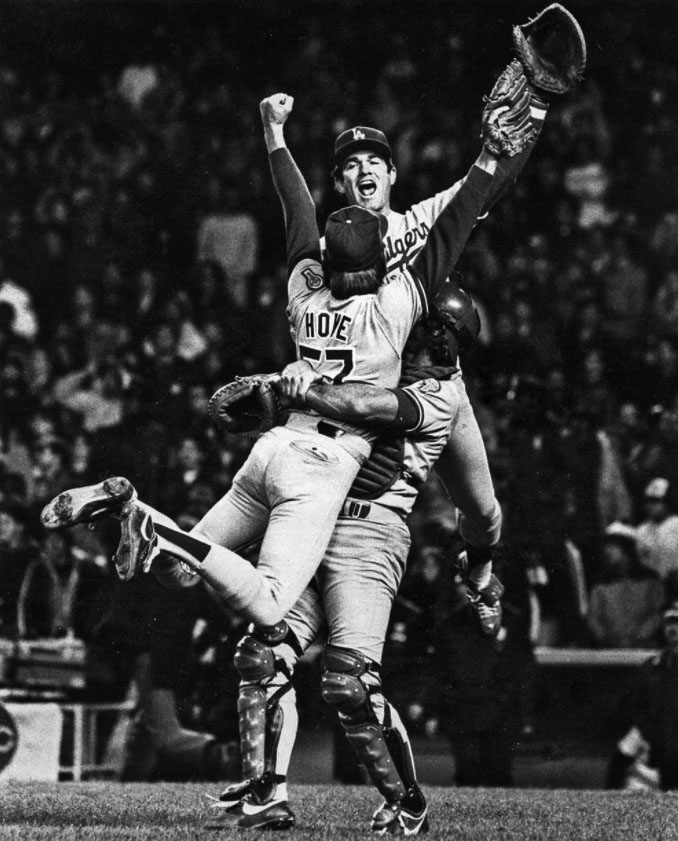 |
|
| (1981)* - Dodgers’ Steve Garvey, Steve Howe and Steve Yeager celebrate winning the World Series. Los Angeles beat the New York Yankees in six games. Los Angeles Times: Framwork |
Historical Notes A page one story in the Oct. 29, 1981, Los Angeles Times reported: Pedro Guerrero drove in five runs with a home run, triple and single and the Dodgers climaxed a remarkable series of playoff comebacks Wednesday night by routing the New York Yankees, 9-2, to win the 78th World Series at Yankee Stadium. It was the fourth straight victory for the Dodgers after they had dropped the first two games at Yankee Stadium. Previously they had come from an 0-2 deficit to beat the Houston Astros, 3-2 in the National League West divisional playoffs and had overcome Montreal, 3-2, after trailing 1-2, in the NL championship playoffs. The result was the exact reversal of the 1978 World Series, when the Yankees lost the first two games at Dodger Stadium, then won the next four. The victory gave Los Angeles its fourth world championship and its first since 1965 when they beat the Minnesota Twins. Previously, they won championships in 1959 over the Chicago White Sox and in 1963 over the Yankees. |
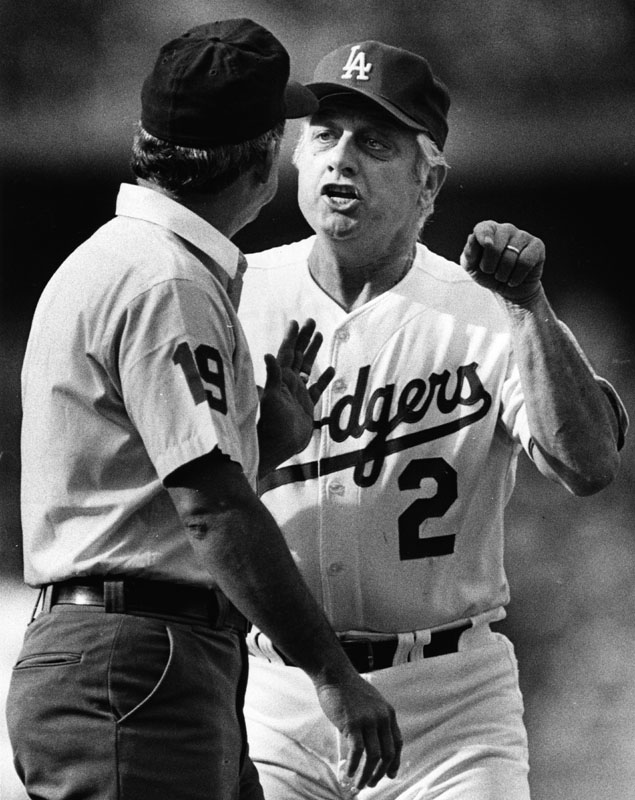 |
|
| (n.d.)* - Dodger manager Tommy Lasorda argues his point with base umpire. |
Historical Notes In 2009, Tommy Lasorda marked his sixth decade in one capacity or another with the Brooklyn/Los Angeles Dodgers organization, the longest non-continuous (he played one season with the Kansas City Athletics) tenure anyone has had with the team, edging Dodger broadcaster Vin Scully by a single season. He was inducted into the National Baseball Hall of Fame as a manager in 1997. |
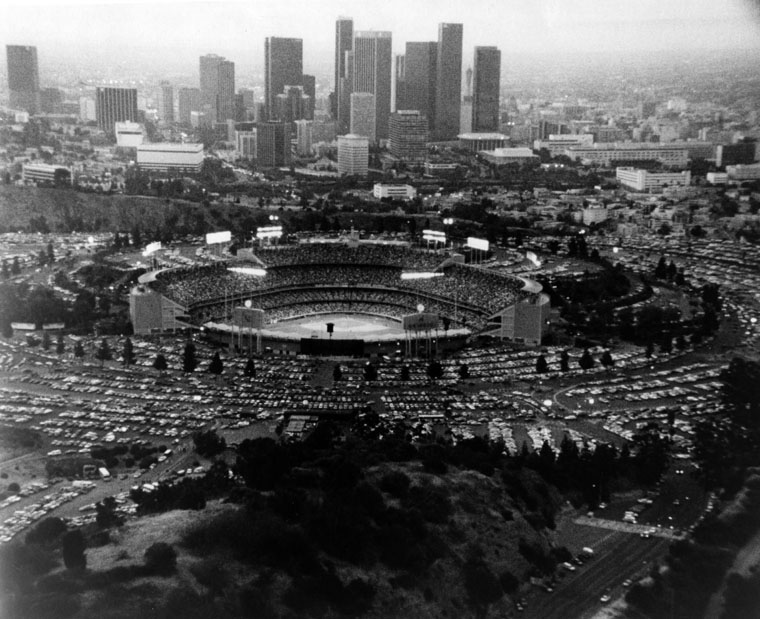 |
|
| (n.d.)* - Aerial view of a packed Dodger Stadium with the tall buildings of the city as a backdrop. Rows upon rows of cars are parked around the stadium and crowds of people fill the bleachers. |
Historical Notes Dodger Stadium is currently the third oldest ballpark in Major League Baseball (behind Fenway Park in Boston and Wrigley Field in Chicago) and is the largest ballpark by seating capacity. It has always held 56,000 fans, due to a conditional-use permit limiting its capacity. Every time the Dodgers add seats, they always remove an equal number of seats in the upper deck or in the pavilion to keep the capacity the same. |
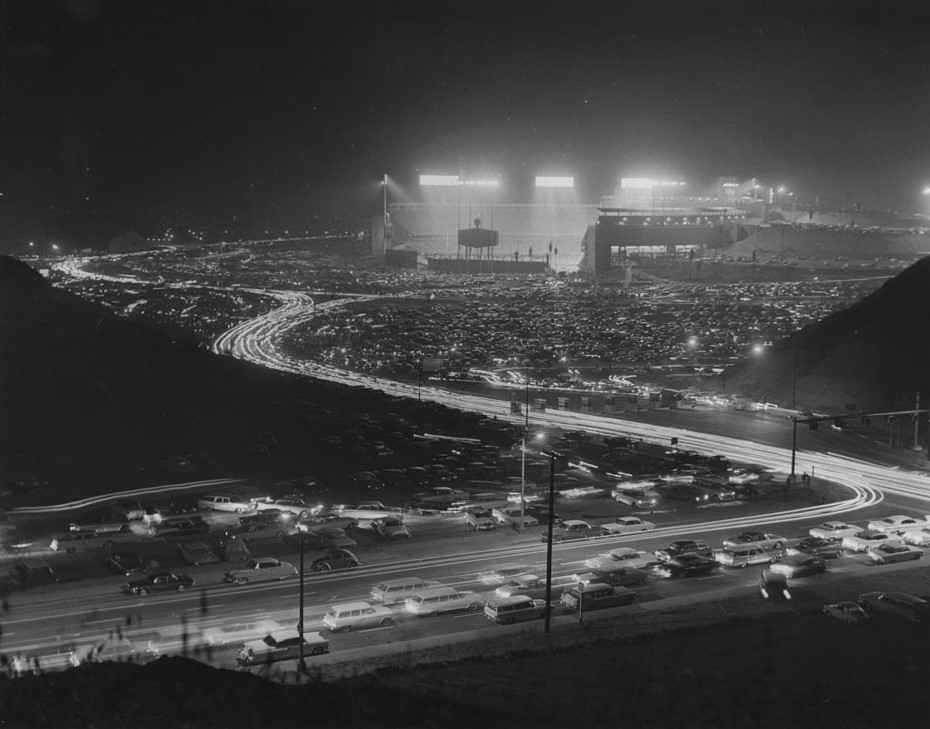 |
|
| (1962)* - Photograph of Dodger Stadium in Chavez Ravine at night, June 1, 1962. The stadium seems to be empty while cars in the parking lot surrounding the stadium sit waiting to leave. |
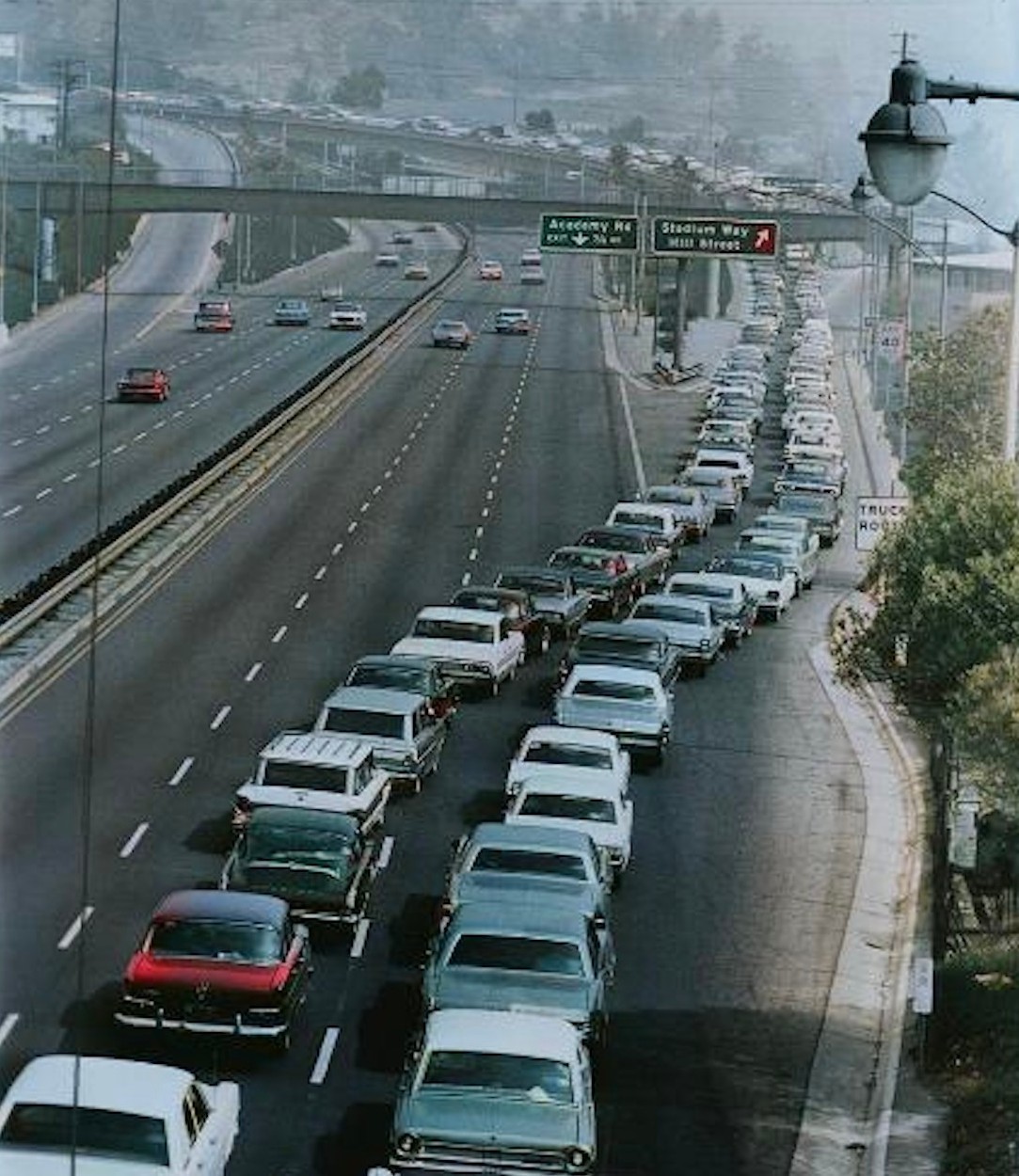 |
|
| (1960s)* - Traffic going into Dodger Stadium. |
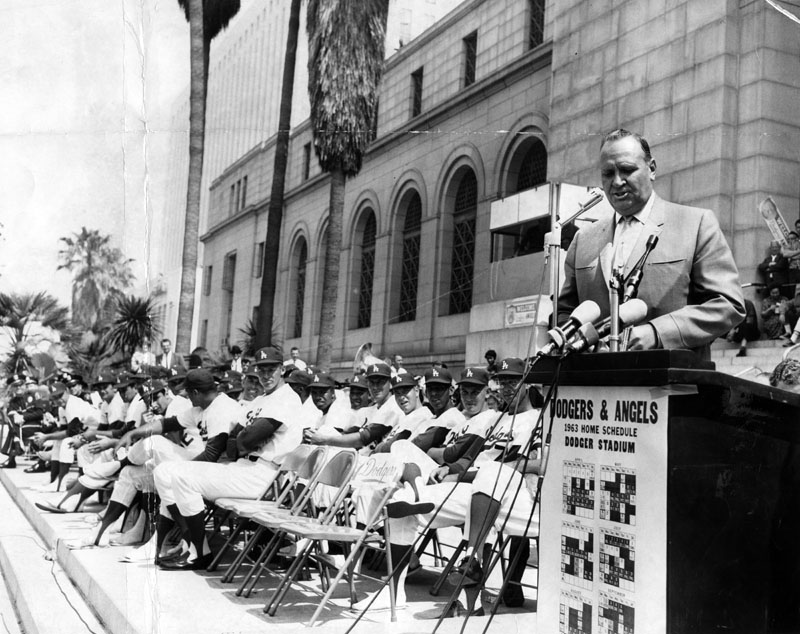 |
|
| (1963)* - Photograph caption dated April 6, 1963 reads, "Gene Autry, co-owner of the Angels, speaks a few words at City Hall ceremonies for the Angels and Dodgers." The Angels would be renting space at Dodger Stadium over the next four seasons until construction of their new stadium was completed in 1966. |
* * * * * |
Angel Stadium of Anaheim (originally known as Anaheim Stadium and later Edison International Field)
The Los Angeles Angels, originally the California Angels, have a rich history that began in 1961. The team has undergone several name changes and has seen many ups and downs, including a World Series victory in 2002. Angel Stadium, their home since 1966, is a historic venue that has hosted numerous significant events and has undergone several renovations to maintain its status as a premier baseball facility.
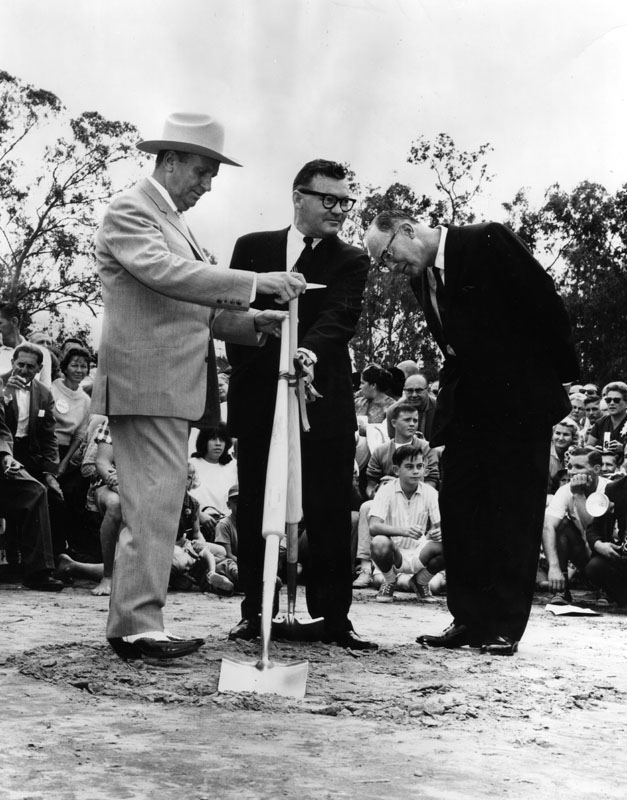 |
|
| (1964)* - The historic groundbreaking for Anaheim Stadium with Angels and City of Anaheim officials and large turnout of fans on hand, August 30, 1966. Participating in two-shovel ceremonies were, from left, Angels Chairman of the Board, Gene Autry, Anaheim's then Mayor Odra Chandler and Conractor Del Webb. The shovels had baseball bat handles. |
Historical Notes Work began almost as soon as the groundbreaking ceremony adjourned. Contractor Del E. Webb, who happened to own part of the New York Yankees, had pledged to complete the $15.8 million stadium by the opening day of the 1966 season. |
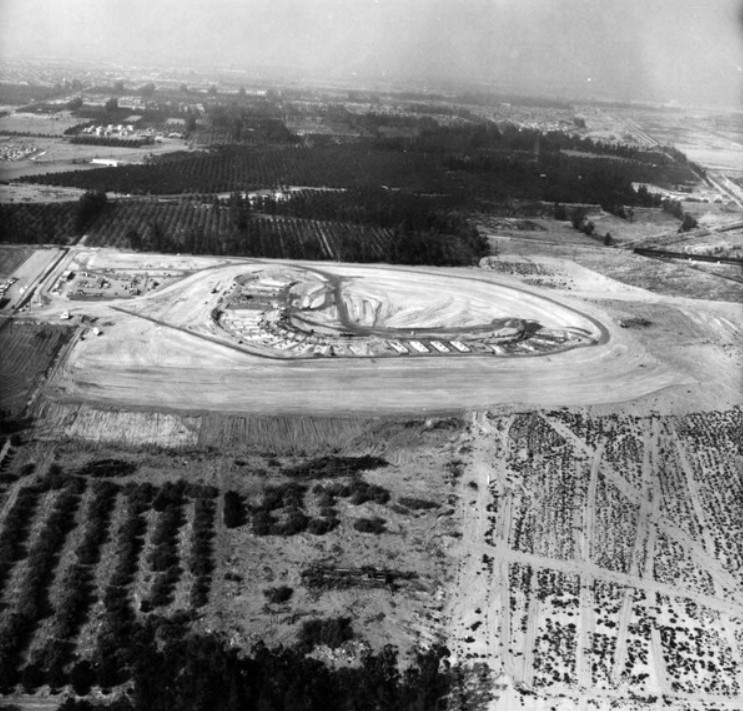 |
|
| (ca. 1964)* - Aerial view of the Anaheim Stadium site post-groundbreaking, but prior to construction, image shows view looking north, with orange groves in foreground and background. |
Historical Notes The stadium was built on a parcel of about 160 acres of flat land originally used for agricultural purposes in the southeast portion of Anaheim. |
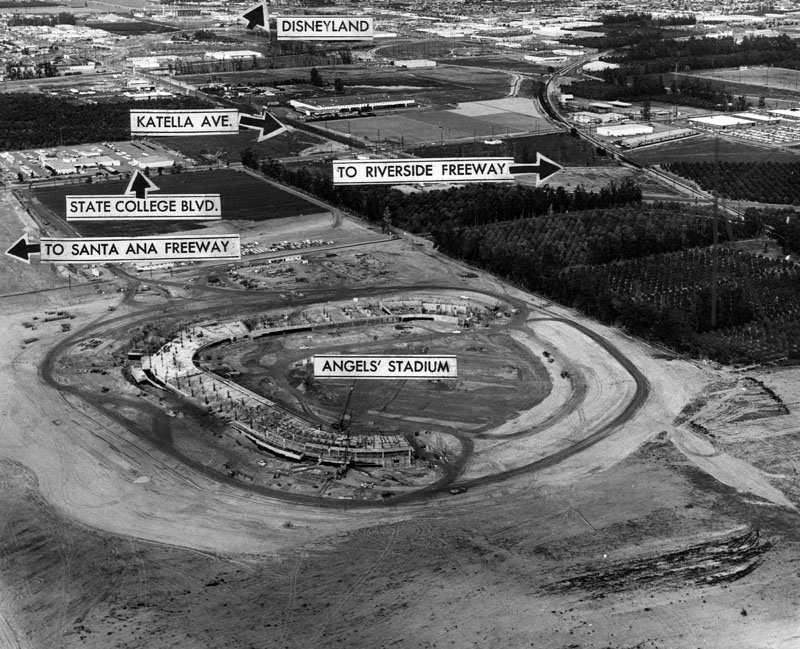 |
|
| (1965)* - Aerial view of the Anaheim Stadium construction site from February 1965 with landmarks labeled. |
Historical Notes Consistent with many major-league sports stadiums built in the 1960s, Anaheim Stadium is located in a suburban area, though one that is host to major tourist attractions. |
 |
|
| (1965)* – Aerial view showing the framework of the new stadium at Anaheim. At the top of photo is the Santa Ana Freeway with Orange Drive-in Theatre at top-center. Photo date: June 11, 1965 - LA Times - Framework |
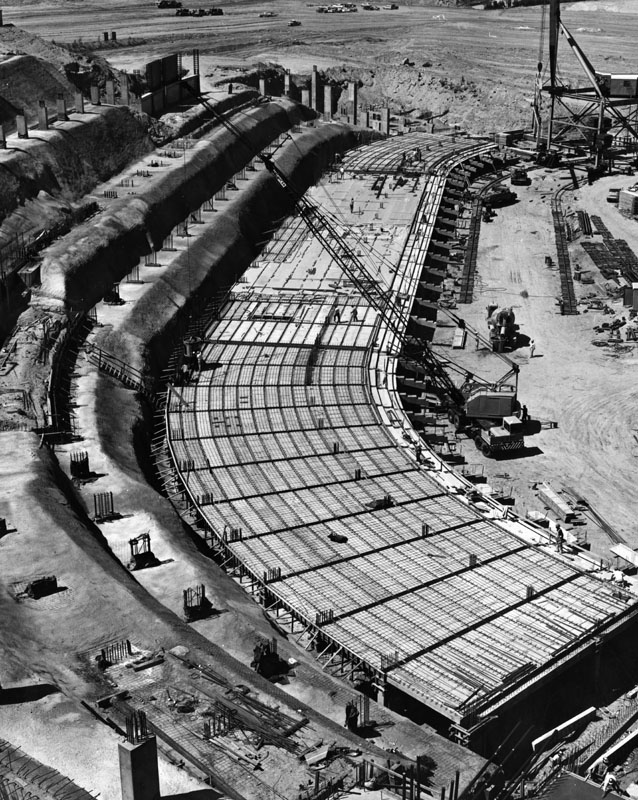 |
|
| (1965)* - View of a crane at work during the construction of the new Angel Stadium in Anaheim |
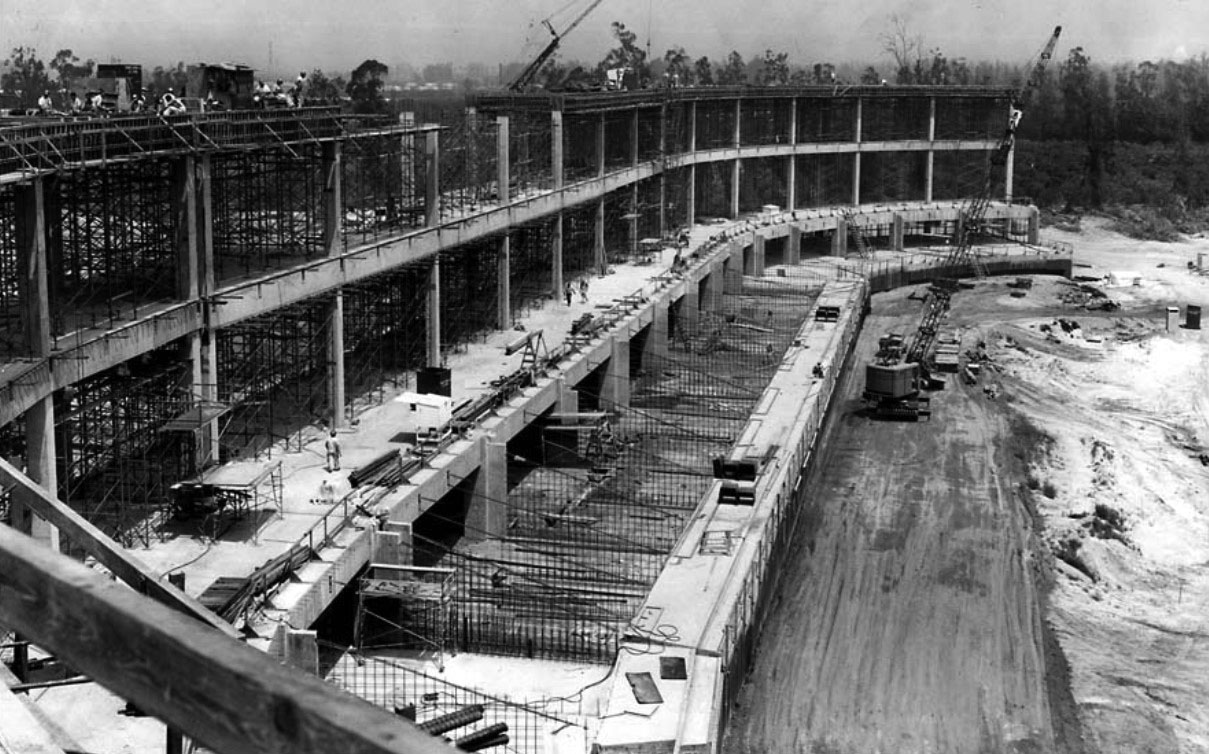 |
|
| (1965)* – Concrete is being poured during construction of Anaheim Stadium. The stadium was 21% completed when this image was taken on April 23, 1965. LA Times - Framework |
Historical Notes Over a 20 month construction period, Del Webb's construction workers poured 42,000 cubic yards of concrete, laid 7 million pounds of reinforcing steel and 8 million pounds of structure steel, and installed 1,900 light bulbs. |
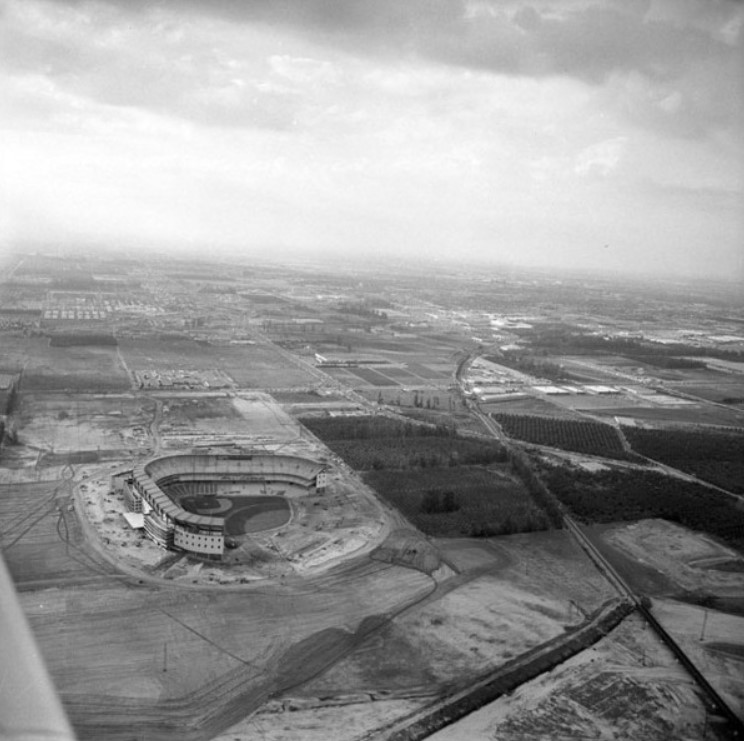 |
|
| (1966)* - Anaheim Stadium rises from a former cornfield in Anaheim. Courtesy of the Los Angeles Times Photographic Archive, UCLA Library. Used under a Creative Commons license. |
Historical Notes The stadium was built on a parcel of about 160 acres of flat land originally used for agricultural purposes by the Allec, Russell, and Knutzen families in the southeast portion of Anaheim. |
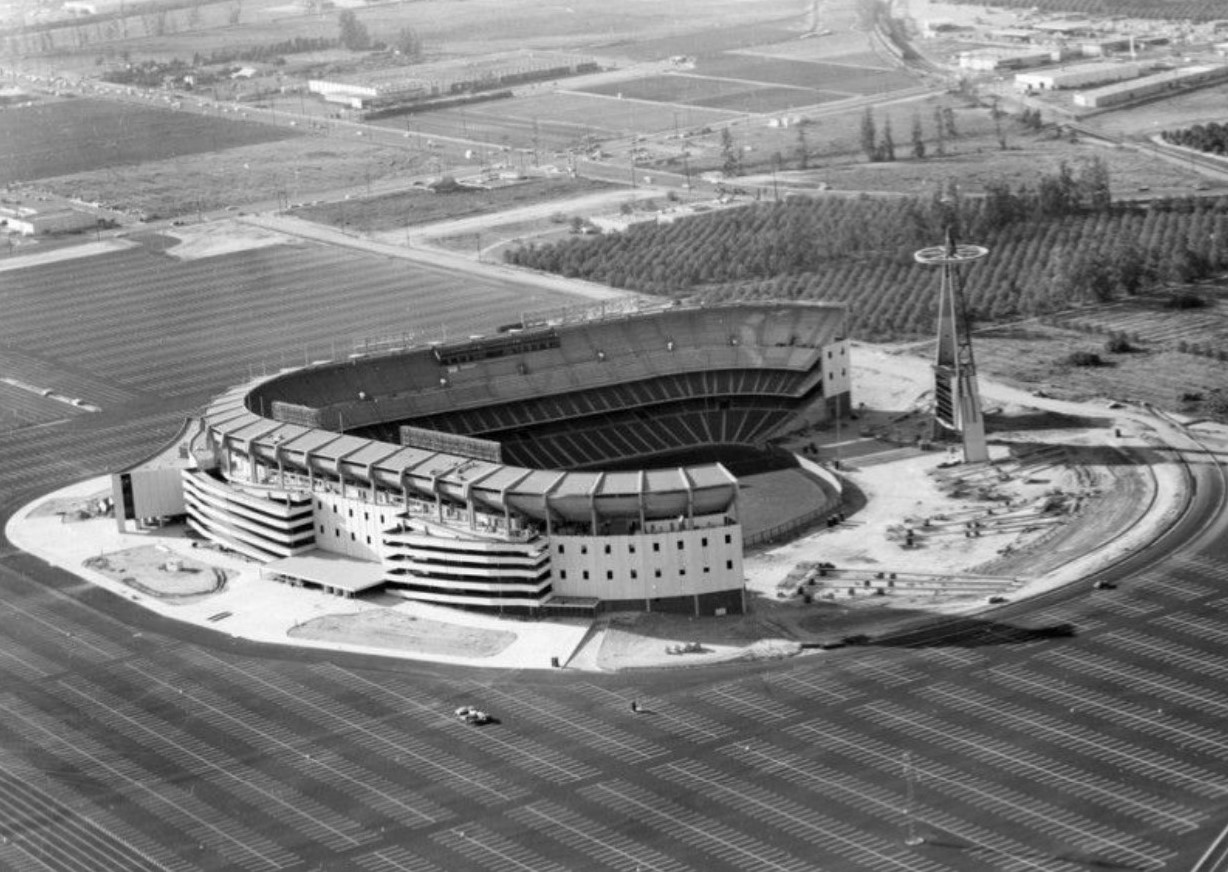 |
|
| (ca. 1966)* - Aerial view of the construction of the new Angel Stadium in Anaheim. Note the stadium lights laying in the foreground waiting to be installled. |
Historical Notes The field dimensions (333 feet instead of 347 or 350, for example) were derived from a scientific study conducted by the Angels. Based on the air density at normal game times (1:30 pm and 8 pm), the Angels tried to formulate dimensions that were fairly balanced between pitcher, hitter and average weather conditions. The Angels tinkered with those dimensions several times, expanding or contracting parts of the outfield by a few feet here and there, to try to refine that balance. 396 feet is the shortest center-field in the American League, and tied for 2nd-shortest in the major leagues with Petco Park behind only Dodger Stadium's 395 feet. |
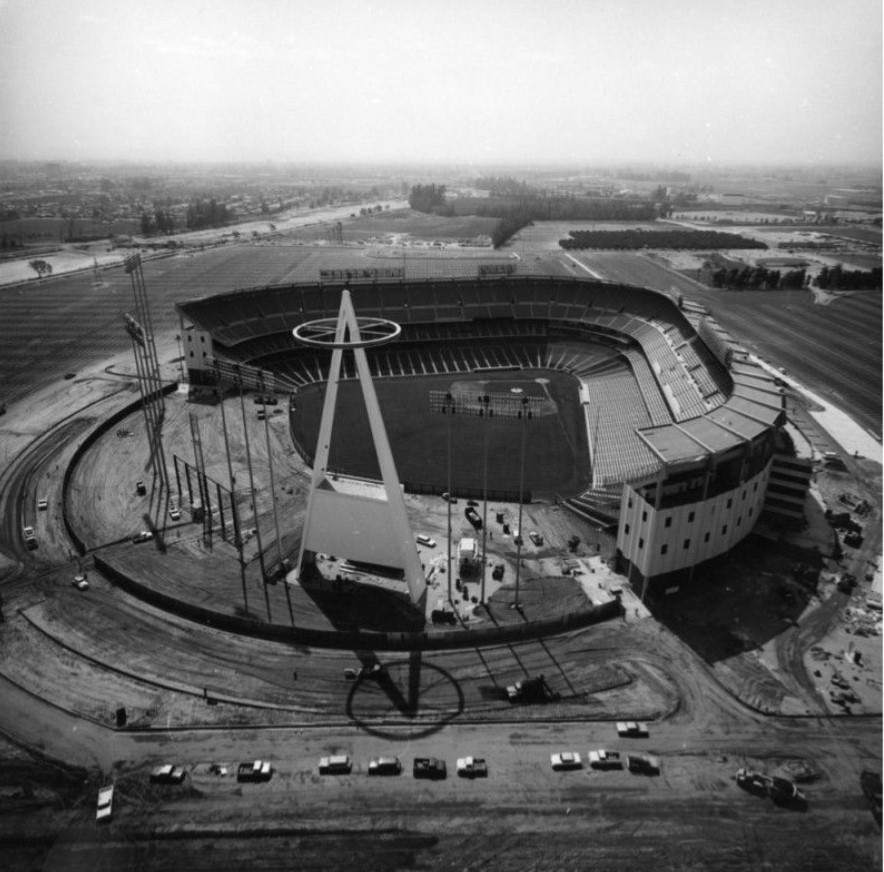 |
|
| (1966)* - View showing the Big A Socreboard during its unveiling. |
Historical Notes The Big A 230-foot high scoreboard support cost $1 million and was unveiled in 1966. It was moved to the parking lot in 1980. |
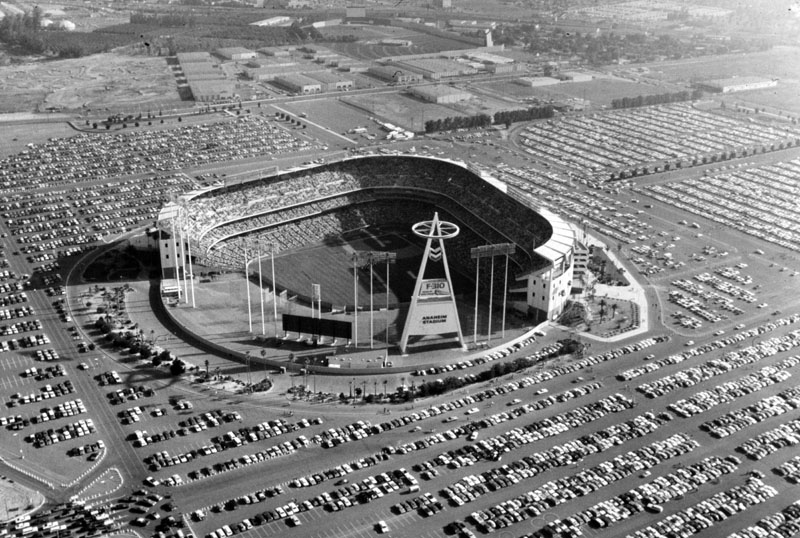 |
|
| (1960s)* - One of the first games to be played at Anaheim Stadium (later known as Angel Stadium). Nothing caught the eye as much as the Big A: a 230-foot-tall A-shaped scoreboard that stood just behind the outfield fence. Naturally, a halo topped the structure. |
Historical Notes Angel Stadium, the fourth oldest active Major League Baseball stadium, was selected to host the 2010 Major League Baseball All-Star Game. The stadium also houses the studios and offices of the Angels' owned and operated flagship radio station, KLAA (830 AM). |
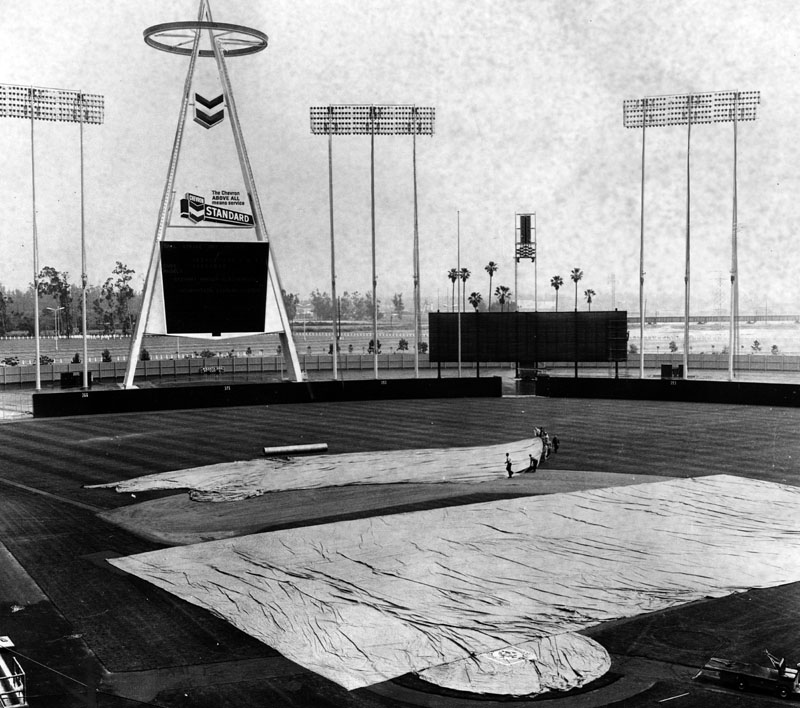 |
|
| (1967)* - View of the outfield and the Big A scoreboard at a rain-delayed game. Note that the stadium originally featured no bleachers or grandstands beyond the outfield. |
Historical Notes The design of the stadium was very similar to the popular Dodger Stadium, but without the outfield seats. Outfield bleacher seats were not in demand, Anaheim being in Orange County did not fit the image of the traditional bleacher bum. So no changes were necessary for this relatively new stadium. However, a new tenant wanted to move in, the Los Angeles Rams, and changes would be required to make this a multi-purpose stadium. Anaheim Stadium became a multi-purpose stadium between 1980 and 1996. When the deal was complete to bring the NFL Los Angeles Rams to Anaheim, major changes were needed. The stadium needed to become enclosed. Enclosing the stadium angered the baseball fans. By building grand stands in the outfield, the views of the mountains and infamous Big A scoreboard were going to be lost. The Big A scoreboard was moved to the parking lot. The additional stands increased the size of the stadium from 43,000 to 65,000. |
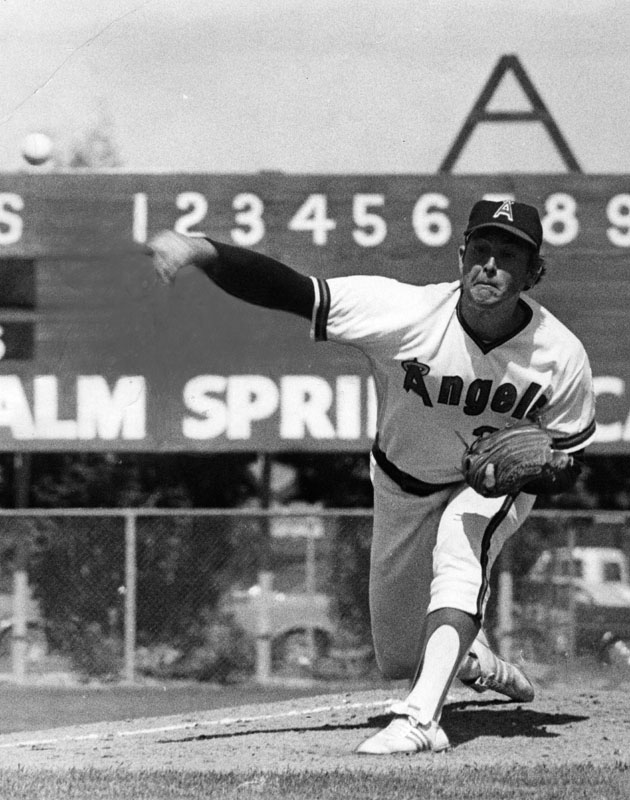 |
|
| (1970s)* - Pitcher Nolan Ryan throws a good one off the mound at Angels camp in Palm Springs. Nolan played on the Angels for eight seasons (1972 - 1979). |
Historical Notes In his first season with the Angels, Ryan, given a chance to pitch regularly as a starter for the first time in his career, had a league-leading 329 strikeouts—nearly a third more than the AL runner-up, and to that point, the fourth-highest total of the 20th century. Within five seasons, the season would only be Ryan's fourth-highest strikeout total. He also set a still-standing Major League record by allowing only 5.26 hits per nine innings, breaking Luis Tiant's 5.30 in 1968, as well as posting a 2.28 earned run average that year, to date the second lowest in franchise history, trailing only Dean Chance's 1.65 in 1964. Though Ryan's actual winning percentage hovered only slightly over .500, his strikeouts and no-hitters brought him media attention. |
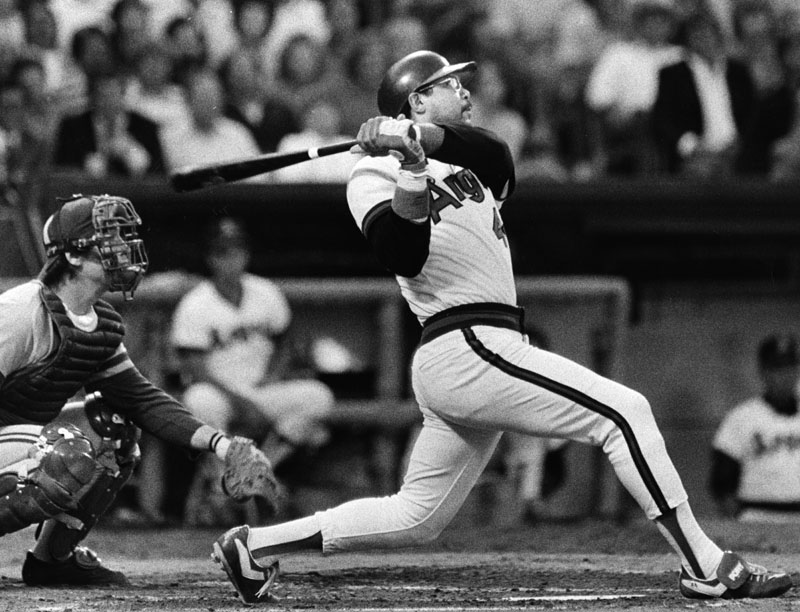 |
|
| (1982)* - This classic Reggie swing produced a classic Reggie home run to dead centerfield. He was a California Angel for 5 seasons (1982 - 1986). |
Historical Notes Reggie Jackson played 21 seasons and reached the post-season in 11 of them, winning six pennants and four World Series. His accomplishments include winning both the regular-season and World Series MVP awards in 1973, hitting 563 career home runs (sixth all-time at the time of his retirement), maintaining a .490 career slugging percentage, being named to 14 All-Star teams, and the dubious distinction of being the all-time leader in strikeouts with 2,597 (he finished with 13 more career strikeouts than hits). Jackson was the first major leaguer to hit one hundred home runs for three different clubs, having hit over 100 for the Athletics, Yankees, and Angels. |
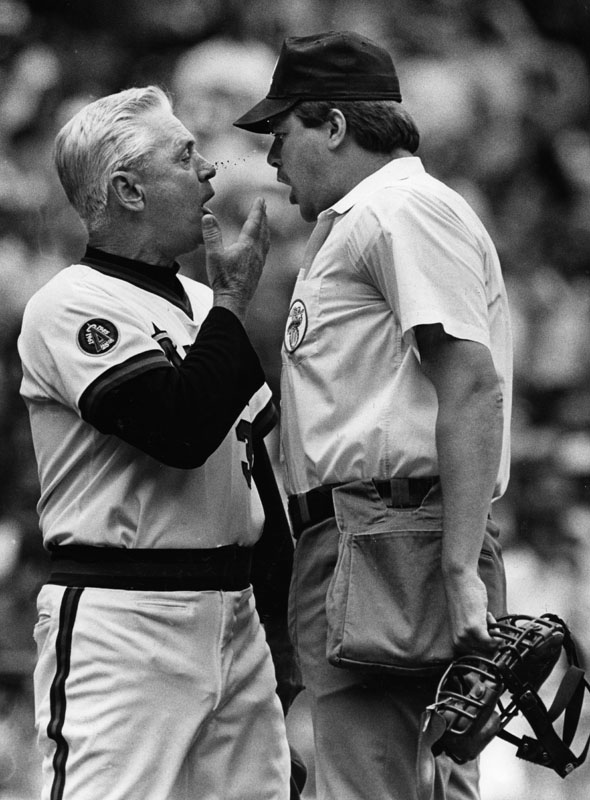 |
|
| (1982)* - Angels manager Gene Mauch (left) was ejected in the top of the first inning after questioning home plate umpire Tim Welke's strike-calling. |
Historical Notes Gene Mauch played in Major League Baseball as a second baseman for the Brooklyn Dodgers (1944, 1948), Pittsburgh Pirates (1947), Chicago Cubs (1948–49), Boston Braves (1950–51), St. Louis Cardinals (1952) and the Boston Red Sox (1956–57). Mauch was best known for managing four teams from 1960 to 1987. He is by far the winningest manager to have never won a league pennant, three times coming within a single victory. He managed the Philadelphia Phillies (1960-68), Montreal Expos (1969–75, Mauch was their inaugural manager), Minnesota Twins (1976–80), and California Angels (1981–82, 1985–87). His 1,902 career victories ranked 8th in major league history when he retired, and his 3,942 total games ranked 4th. He gained a reputation for playing a distinctive "small ball" style, which emphasized defense, speed and base-to-base tactics on offense rather than power hitting. Mauch gained a reputation for being loyal to his players and became known as the Little General. |
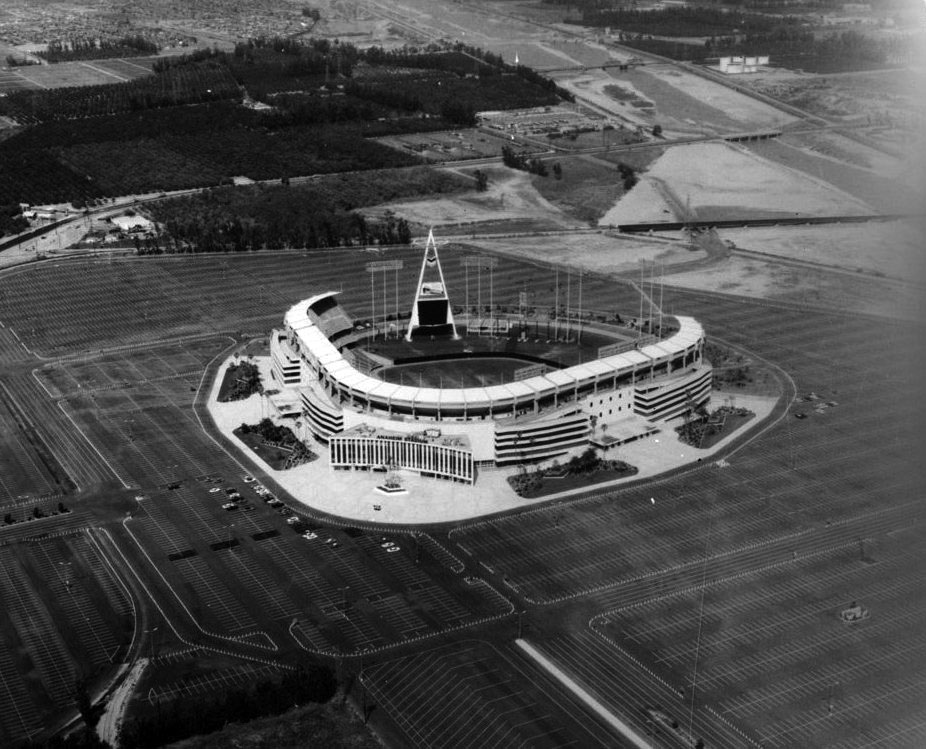 |
|
| (1968)^ - Aerial view of Anaheim Stadium. The parking lot looks empty except for a few cars near the stadium entrances. |
Historical Notes The original Anaheim Stadium seated 43,204 (later 43,250). The stadium underwent construction in 1979-80 for additional seating to accommodate the Los Angeles Rams of the NFL. Upon completion in 1981, the stadium seated 65,158 (later 64,593) for baseball. The Rams left Anaheim for St. Louis, MO in 1995. The new Angel Stadium of Anaheim has a seating capacity of approximately 45,050 for the Los Angeles Angels. |
 |
|
| (1970s)^ – Aerial view of Anaheim Stadium before it was totally enclosed. Photo Courtesy of Angels Baseball |
Historical Notes In the late 1970s, Anaheim Stadium tried to earn extra revenue any way it could. It staged more rock concerts, motocross events and brought in new (and briefly) successful tenants in soccer’s California Surf and the Southern California Sun of the short-lived World Football League. But just as they had wooed an unhappy Angels franchise out of Dodger Stadium 15 years earlier, local politicians were now sniffing out another disgruntled tenant in 1978 when they heard that the NFL’s Los Angeles Rams were looking to upgrade from their current situation at the ancient Los Angeles Memorial Coliseum. Anaheim and Orange County were hardly clandestine in their efforts to woo the Rams, even placing a full-page pitch to them in the Los Angeles Times. The ballpark would do more than just add 20,000 makeshift seats in right field, as had been planned for the Chargers back in 1966; this time the idea was to turn Anaheim Stadium into a fully enclosed, multi-purpose facility, tucking into the back of the second level 107 brand new luxury suites—all for the Rams to own and profit from. Like Gene Autry before him, Rams owner Carroll Rosenbloom was happily on board with the concept and told Anaheim he’d be theirs. Autry and the Angels were fine with the ambitious $33 million project to enclose and expand Anaheim Stadium to 67,000 seats, even if it meant wrecking the baseball ambience. Just to be sure there was no ill will, the Rams played nice and offered to buy Angels season tickets for every row that butted up against the front of the new luxury boxes. But when Autry discovered that the expansion pact also called for a high-rise business complex to be built for the Rams on part of the existing parking lot, smiles became snarls. The Angels sued Anaheim, triggering a 12-year battle in which the Angels, the Rams and the City of Anaheim all took turns suing one another over control of the parking lot. Finally, in 1994, it was ruled that the lots belonged to the city but needed to be fully used by the Angels, negating any chance for development. |
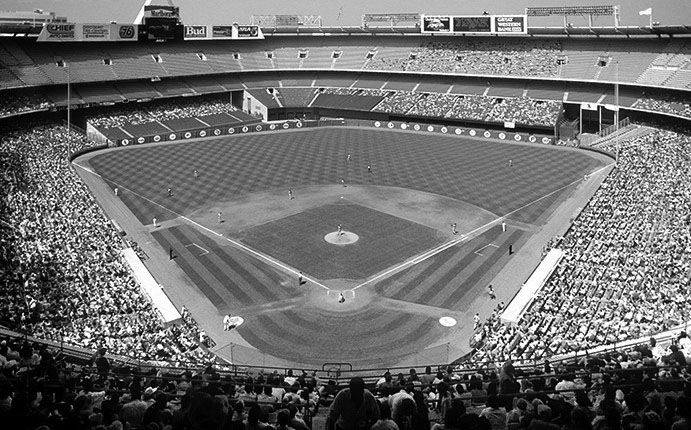 |
|
| (1980s)^ - Anaheim Stadium after being enclosed to accommodate football. The field dimensions were kept symmetrical in front of a purely asymmetrical bleacher setup. Photo Courtesy of Angels Baseball |
Historical Notes The Big A scoreboard was moved to the south end of the parking lot when Anaheim Stadium was enclosed in 1980. Talk of bringing it back during the ballpark’s second makeover ended when it was determined it would be too costly to do so. In 1998, the stadium was renamed Edison International Field of Anaheim after local utility Edison International reached a deal giving it naming rights over the stadium for 20 years, and during this time, the stadium was referred to as the Big Ed. However, after the 2003 season, Edison International exercised its option to exit the sponsorship deal. On December 29, 2003, the Angels announced that from then on the stadium would be known as Angel Stadium (in full, Angel Stadium of Anaheim), some locals can still be caught calling the venue by its original name; Anaheim Stadium as well. After the name change in 2004, its original nickname The Big A was restored. Despite efforts to cover them up with the Angels' halo insignia, Edison's insignia can still be found on the ends of seating rows throughout the ballpark. |
* * * * * |
More Historical Early Views
Newest Additions
Early LA Buildings and City Views
History of Water and Electricity in Los Angeles
* * * * * |
References and Credits
* LA Public Library Image Archive
^*Library of Congress: Washington Park
^^Rule 19 Blog - Vernon Tigers
#*Facebook: Photos of Los Angeles
^#Nuestra Señora la Reina de los Ángeles: losangelespast.com
^**Hidden Los Angeles - Facebook.com: Sandy Koufax
^^*Skyscraperpage.com: Team Photo
^^^KCET: When the Los Angeles Angels Flew to Anaheim
^*^Anaheim Public Library Image Library
*#*Pinterest.com: Memories in the SFV, 60's, 70's, & 80's
*#^Gizmodo.com: How 19 Earthmovers Carved Dodger Stadium
^#^Calisphere: University of California Image Archive
**#Sports-Venues.info: Anaheim Stadium
#**Classic Hollywood/LA/SFV - Facebook.com
#^^100 Years of Scoreboard Watching
*^Wikipedia: Dodger Stadium; Angels Stadium; Nolan Ryan; Reggie Jackson; Los Angeles Angels (PCL); Los Angeles Angels of Anaheim; Gilmore Field; Chutes Park; Gene Mauch; Hollywood Stars; Bill Russell; Davey Lopes; Tommy Lasorda; L.A. Dodgers - 1959 Season; Walter Alston; Sandy Koufax; Johnny Podres; Tommy Lasorda; Vince Scully
< Back
Menu
- Home
- Mission
- Museum
- Major Efforts
- Recent Newsletters
- Historical Op Ed Pieces
- Board Officers and Directors
- Mulholland/McCarthy Service Awards
- Positions on Owens Valley and the City of Los Angeles Issues
- Legislative Positions on
Water Issues
- Legislative Positions on
Energy Issues
- Membership
- Contact Us
- Search Index